Australian
and international
exploratory
performance and
media arts
Adelaide’s OzAsia Festival proves more than ever to be vitally enticing with a program featuring great artists and works unfamiliar to Australian audiences. This week in an interview with Artistic Director Joseph Mitchell we focus on key performance works including those from Japan by theatre-maker Kuro Tanino, conjuring haunting inner worlds, and leading composer and experimentalist Keiichiro Shibuya, probing the mind of a virtual performer, the massively popular Miku Hatsune (image above) in The End, an opera he’s written for her. An acclaimed five-hour play from Singapore’s W!LD RICE courses through 100 years of the city state’s history. Next week we look at inventive Asian-Australian collaborations and, later, the festival’s fascinating visual arts showings. As Peter Dutton takes control of state power and foreshadows the end of compulsory voting with his referendum by postal vote — in the age of the internet! — OzAsia invites a greater sense of distance from what it is to be, often all too lazily, Australian. Keith & Virginia
–
Top image credit: The End, Keiichiro Shibuya + Hatsune Miku, photo Kenshu Shintsubo courtesy OzAsia 2017
If there has ever been a necessary moment for Australians to be ‘taken out of ourselves,’ to evaluate our cultural and political place in the world as geopolitical tectonic plates shift us away from the US, it is now. Once ‘outside’ we can open up to and appreciate cultures substantially different from our own, look back at ourselves and acknowledge the art growing here that tells us how Asian-Australian our culture has become, alongside and entwined with our European and Indigenous heritages. With an intensive program, at once accessible and provocative, Adelaide’s annual OzAsia Festival continues to temporarily relocate and enduringly reshape our collective imagination with intensive and seductive programming.
When we meet in Sydney prior to the launch of the 2017 program, I ask OzAsia’s Artistic Director Joseph Mitchell about the progression of his programming over his three festivals since 2015. He tells me that after “breaking down the fourth wall” with immersive contemporary Asian works (including visual and performance art) in his first festival, in his second he focused on works that commented on their countries of origin (including the strange cultural and economic relations between America, Japan and Korea in Toshiki Okada’s wonderfully absurdist God Bless Baseball), “along with a brushstroke picture of the city/rural divide” (as in the wildly funny and socially critical Chinese production Two Dogs, an exemplar of the merging of traditional and modern popular performance).
In his third festival, Mitchell says he’s “going in deeper with a large focus on very personal and intimate stories told from Asia and with more Asian-Australian collaborations, in the arcs of dance as well as in theatre.” As our conversation continues, it becomes clear that the ‘personal’ will be framed within mythology, history and gender as will a focus on artists who are setting the agenda for furthering 21st century Asian and global culture.
Next week we’ll survey collaborative Australian and other works in the festival’s program and, shortly after, the visual arts component. This week Mitchell and I focus on the major theatre and music components.
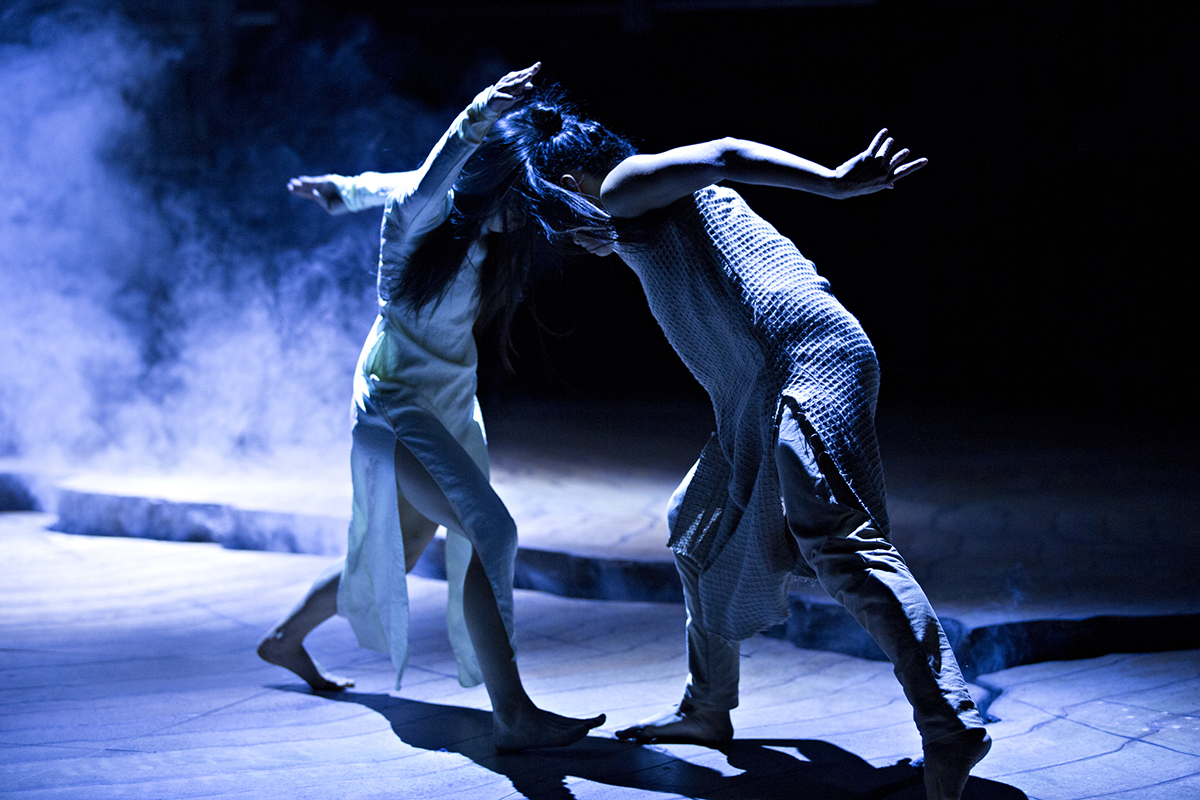
Until the Lions, Akram Khan Company, photo Jean Louis Fernandez courtesy OzAsia 2017
Akram Khan Company, Until the Lions
At first glance, British choreographer Akram Khan’s acclaimed Until the Lions, a dance adaptation of a story from the Mahabharata, seems an unlikely ‘personal’ tale. Mitchell explains, “It is a big work, with a big set, but it’s a particularly individual story. The creators, Khan and poet Karthika Nair, have focused on a story they convey from a female perspective about a princess, Amba, who is abducted by a general, Bheeshma, and she seeks venegeance.” Nair had gathered stories about often unacknowledged female characters from the Mahabharata in her book of poems Until the Lions, which became the title of her collaboration with Khan. In an unusual twist, Amba kills herself, is reborn and changes gender to defeat Bheeshma. Nair has explained the title: it’s based on an African saying about who gets to tell the story after the hunt — usually the hunter; but the tale is not properly told until the lions speak; as it should be for the women in the male-dominated Mahabharata.
Although British reviewers have praised the work for its adroit abstraction and use of symbolism, Mitchell says, “dance theatre is such a loose term, but Until the Lions is a narrative told through dance in 55 minutes. “As with a play, “you need to watch and decode to understand.” A YouTube trailer offers glimpses of an engaging blend of the literal and its abstraction, particularly in fight scenes.
Recalling Mother
Mitchell describes Recalling Mother as conversational performance but also as another very physically expressive work. Singaporeans Claire Wong and Noorlinah Mohamed are friends who explore their relationships with their non-English speaking Cantonese and Malay mothers, taking turns to play each other’s mother in mother-daughter dialogues. Mitchell tells me that when the work was first performed almost 12 years ago, the emphasis was on comedy and the language and culture-clash tensions “between tradition and Singapore’s slightly hybridised Western identity. The humour is still there, but the artists don’t remount the play so much as recreate it now that one of the mothers has dementia and the role of carer and a sense of mortality have entered and intensified the sentiment. The show runs for 75 minutes but with a Q&A which the artists see as part of it, because they feel audience members need to debrief about their own relationships with their mothers.”
In an interview, Noorlinah Mohamed said of Recalling Mother, “It is perhaps the first and only theatrical project, that when restaged, is always revisited as a new creation. The work is a living durational performance where life and art parallel and inform each other.”
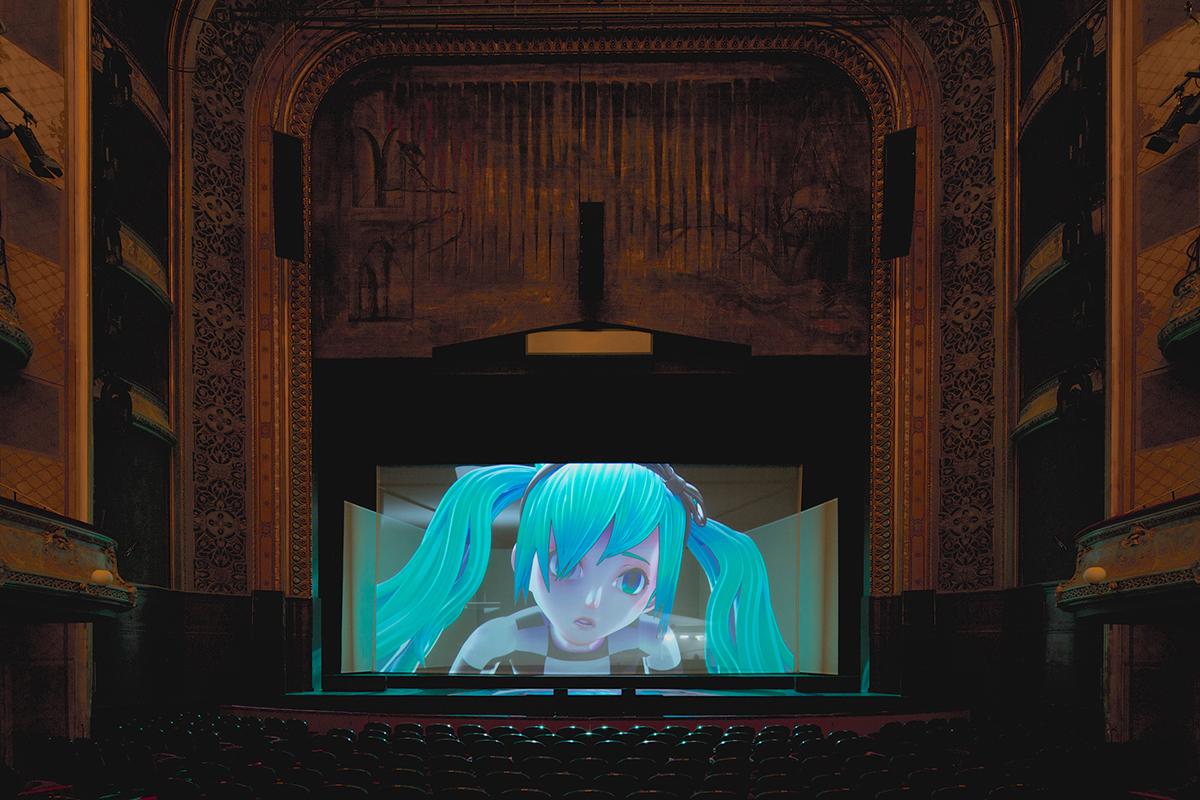
The End, Keiichiro Shibuya + Hatsune Miku, photo Kenshu Shintsubo courtesy OzAsia 2017
Keiichiro Shibuya + Hatsune Miku, Vocaloid Opera: The End
The sense of the personal might seem to evaporate when contemplating two works by a Japanese artist which feature non-human performers: one with a vocaloid (think singer + android) and a robot. Of Asian artists setting the agenda in performance, Mitchell sees Japan’s Keiichiro Shibuya, “with his bold sense of provocation,” as the standout exemplar. He has created The End, an opera for theatre without live singers or an orchestra for virtual pop idol Hatsune Miku. Mitchell says, “she is one of the biggest pop stars in the world. She has some 100,000 pop songs about teen love and relationship breakups, composed by professional teams but also by hardcore fans via purchased software. Shibuya had been a fan and when his wife, a leading fashion designer, died and he spiralled into depression, he latched onto thinking about the nature of death and how Miku will never die. He thought, ‘What if I go into her psyche and find out who this vocaloid is, loved by the world?’ So he asked the novelist, playwright and Artistic Director of chelfitsch, Toshiki Okada, to write the libretto and approached Louis Vuitton to design Miku’s outfits for a giant opera. It’s the most elaborate of her set-ups for an appearance and involves four screens and a mini-screen behind which Shibuya plays the music live.”
Mitchell notes that “When The End debuted Miku’s fans turned out: they were nervous, keen to support her doing opera, hoping she’d last the distance, but had faith in her and were very excited to see her dressed by Vuitton. It went to Europe last year, a bit outside her realm, but created a fusion of arts lovers and fans.” He does believe The End “has to be a dividing piece in terms of the operatic voice. However, the score and the libretto have all the hallmarks of great operatic tragedy and self-insight. At a time of the Australian Government review of opera, a decline in audience numbers and the large cost of the subsidy involved, we need to think about the artform and let it evolve; this work points a way.”
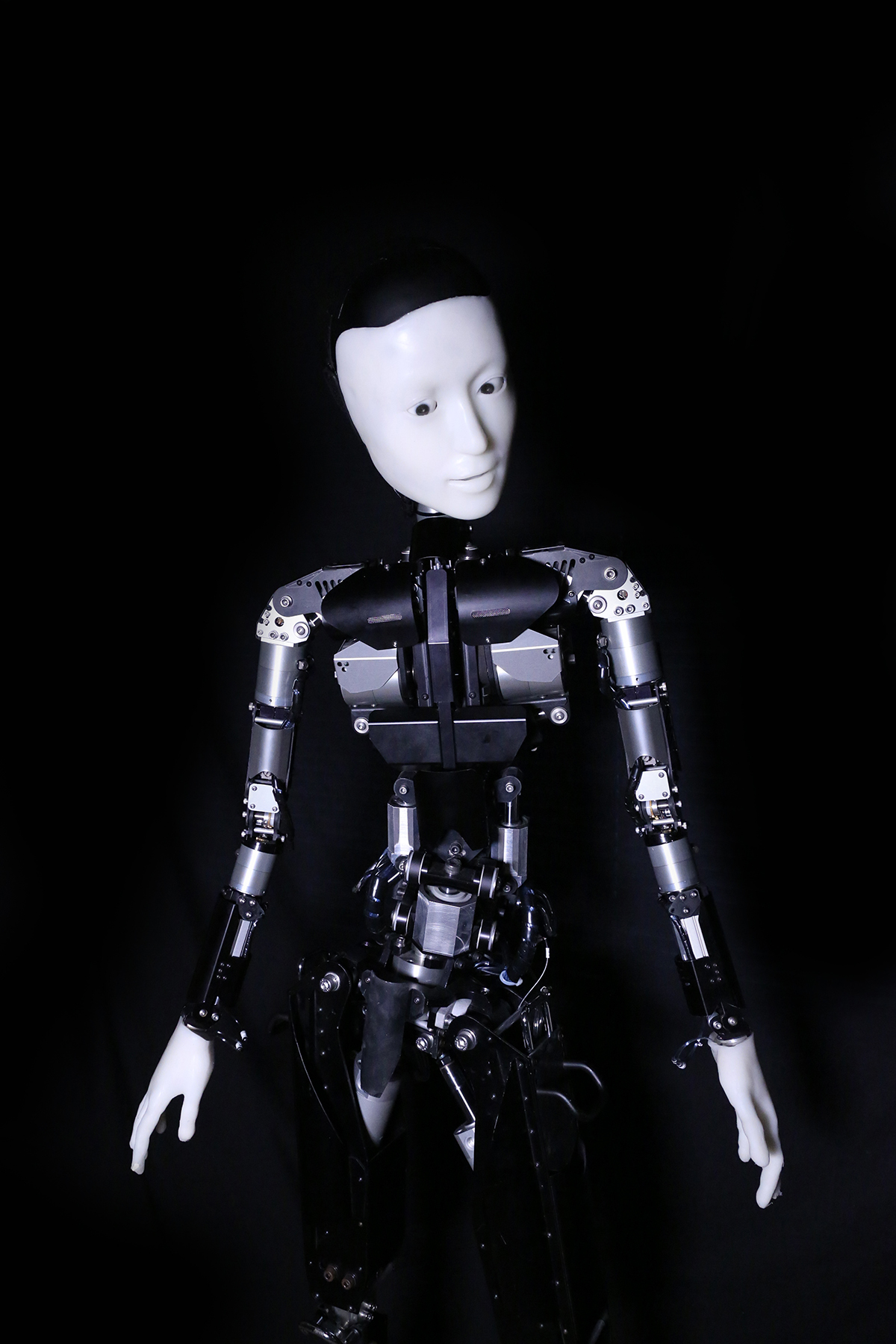
Skeleton, Ishiguro Lab, Osaka University, photo Justine Emard, courtesy OsAsia 2017
Australian Art Orchestra: Keiichiro Shibuya, Scary Beauty
Shibuya makes another appearance in OzAsia 2017 with Scary Beauty, again with a non-human performer — Skeleton, a singing robot with its own neural network — and, again, imagined as a large-scale work. But, says Mitchell, that would have taken years to develop, so the artist was commissioned to present a version of the work with the incisively adventurous Australian Art Orchestra, led by Peter Knight, as part of an afternoon of three discrete concerts featuring Shibuya, guzheng player Mindy Weng Wang and, in Seoul Meets Arnhem Land, Ecstatic Beauty, the pairing of Korean ‘street opera’ singer Bae Il Dong and Daniel Wilfred from the Wagilak clan in the Northern Territory.
Joseph Mitchell sees a widespread preoccupation with robots as workers and service providers as ignoring the rise of AI, which demands of us a better sense of what it is to be human; that, he thinks, can come through art and the challenges offered by works like Skeleton. This cluster of concerts should be a festival highlight, invoking living heritage and evoking possible futures.
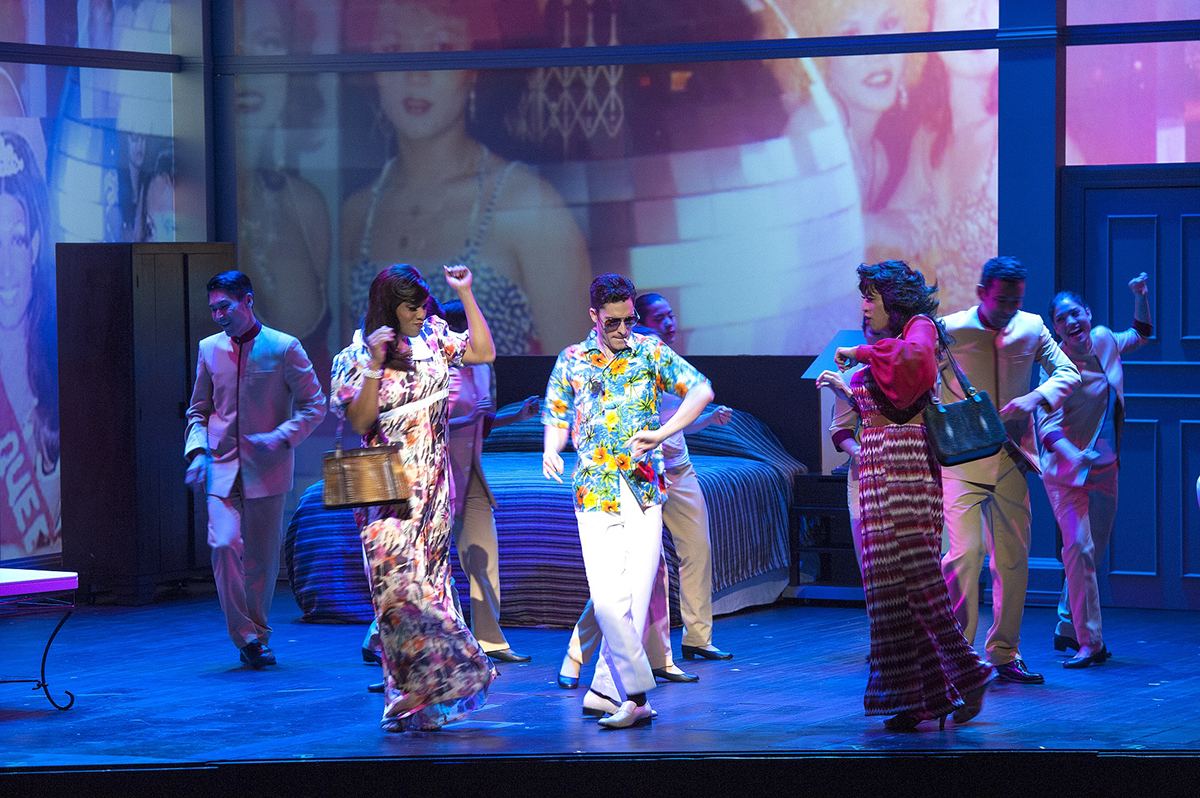
Hotel, W!ld Rice, photo courtesy OzAsia 2017
W!LD RICE, Hotel
The personal is given an epic dimension in W!LD RICE’s Hotel, 100 years of Singapore’s history performed over five hours. Mitchell describes himself as a slow decision-maker, but within minutes of seeing Hotel he knew he had to program it: “We have to do this, no matter what. It’s one of the best theatre works I’ve seen in the last few years and has never had a bad review. You can see it all at once or in parts and is a bit like watching a Netflix series — there are 11 stories of some 20 minutes each, with characters and incidents overlapping, characters ageing across 40 to 50 years and told through the lives of ordinary people — from British colonialism to the Japanese occupation, independence and the explosion of today’s queer culture.” The hotel is unnamed, but it’s easy to guess it’s Raffles and all that it has symbolised. Mitchell feels that, like Australia’s widely played Secret River, Hotel is a story that needs to be told. Read more about Hotel, Mitchell’s first large scale work for OzAsia, here.
Niwa Gekidan Penino, The Dark Inn
Although enamoured of earlier works by Kuro Tanino and determined to program him in OzAsia, the auteur’s most recent work, The Dark Inn, proved to be Mitchell’s ideal choice. “The early work was really ‘out there.’ Kuro’s a trained psychiatrist who has worked with a lot of people who don’t see the world the way we do, so he created theatre from their viewpoint. The sets were crazy, with strange dimensions: there were penises across the stage. I saw The Dark Inn in Kyoto last year and agree with people who think this is Kuro’s masterpiece. It won the Kishida Prize for Drama.
“A dwarf father and his tall son are travelling puppeteers booked to play in a country bathhouse but arrive to find a disparate bunch of characters who are not expecting them. In the kind of revolving, multi-level set Kuro’s famous for, with a Japanese bath, steam, inquisitive characters and odd conversations, the play is more about inner states of mind than a straight narrative.” Mitchell adds, “After appearing in major US and European festivals, this is Kuro’s first visit to Australia and is a great opportunity for audiences and those attending the Australian Theatre Forum during OzAsia to see new directions offered by this kind of work.”
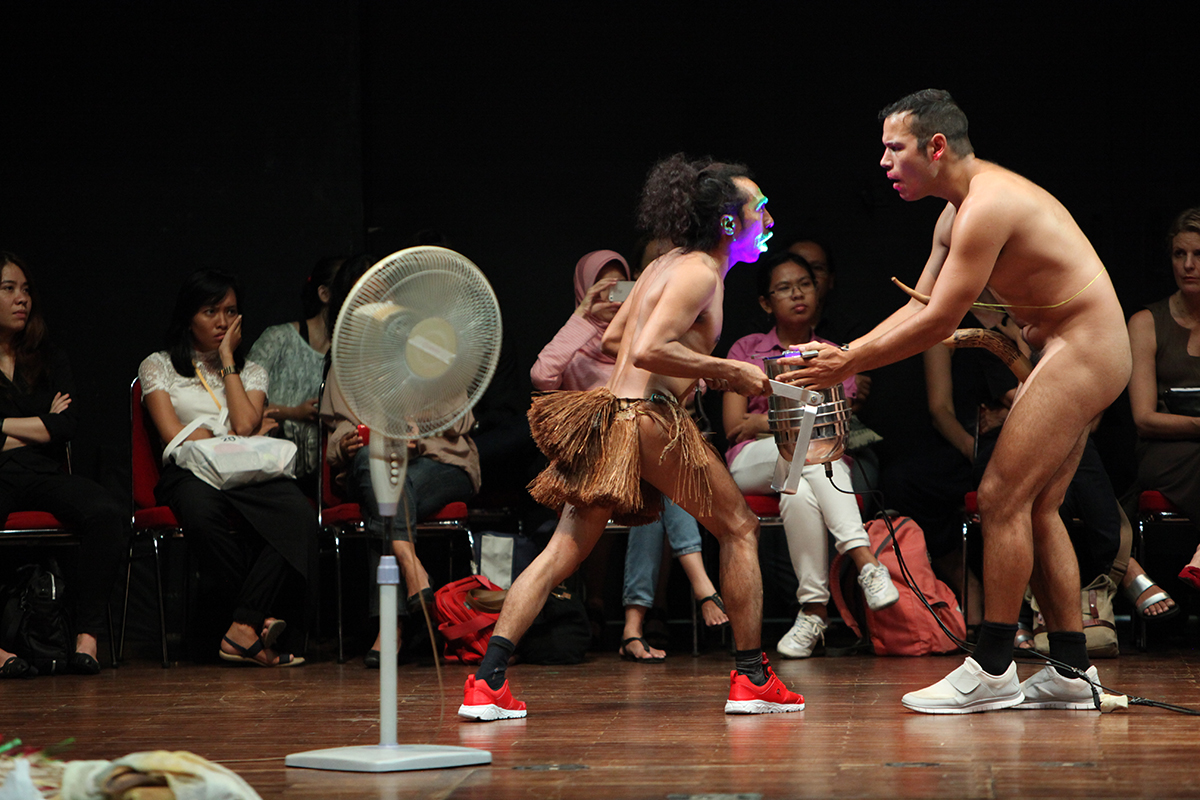
Darlane Litaay, Tian Rotteveel, Specific Places Need Specific Dances, photo courtesy Indonesian Dance Festival & OzAsia 2017
Specific Places Need Specific Dances
The collaborative dance work Specific Places Need Specific Dances foregrounds personal desire. Darlane Litaay from Papua New Guinea and Tian Rotteveel from Germany, investigate “waiting in different places, sharing culture and exchanging daily habits” (program). Each visits the other’s home country out of curiosity, says Mitchell, “Darlane to experience Berlin’s underground club and dance scene, Tian to see traditional male garb and in particular the penis horn. To Western eyes, these can appear sexual and as empowering the male figure. There are readings you can take from this work about exchange, sexuality, queer culture and male identity. For me, this is a work which sits at the cutting edge of contemporary dance.” Two more artists, in their Adelaide premieres, confirm Mitchell’s commitment to dance that draws on tradition and local cultures while venturing in new directions.
Aakash Odedra Company, Rising
Aakash Odedra will perform a self-choreographed contemporary Kathak piece and works made for him by Akram Khan, Russell Maliphant and Sidi Larbi Cherkaoui. Maggi Philips wrote of the performance at the 2015 Perth Festival, “Odedra’s presence and collaboration with an impressive list of contemporary choreographers delivered a sense of celebration awakened in a performance which gathered strength from tradition and experimentation alike, yet was humble and projected humankind as simply strange and remarkable in a world of mystery, beauty and pain.”
Eisa Jocson, Macho Dancer
Eisa Jocson, who has appeared in Performance Space’s Liveworks in Sydney and Melbourne’s Asia TOPA, performs her eerie, gender-bending solo work Macho Dancer, drawn from her personal observations of Filipino club dancers. She said in an interview in RealTime, “Macho dancing is performed by young men for both male and female clients. It is an economically motivated language of seduction that employs notions of masculinity as body capital. The language is a display of the glorified and objectified male body as well as a performance of vulnerability and sensitivity.”
I wrote of this striking performance in 2015, “Jocson becomes a young, gum-chewing male dancer passing though a series of telling phases in which he is variously proud, defiant, calculatingly erotic and sulky; at one point he stops dancing and withdraws into upstage shadow — a tease or a moment of existential doubt?”
We’ll tell you more about Joseph Mitchell’s third OzAsia Festival in coming weeks, but already I feel a sense of eager anticipation building around the prospect of entering the idiosyncratic worlds of Akram Khan, Keiichiro Shibuya, Kuro Tonini, W!LD RICE and Darlane Litaay and Tian Rotteveel, with their offers of opportunities to redefine art and self.
–
OzAsia Festival, 2017, Adelaide, 21 Sept-8 Oct
Top image credit: The Dark Inn, Niwa Gekidan Penino, photo Shinsuke Sugino courtesy OzAsia 2017
Natalie Abbott’s (re)PURPOSE: the MVMNT stages a whimsical and somewhat desultory encounter with The Dying Swan, Mikhail Fokine’s classical ballet solo from 1905. Not that this is in any sense an illustration or adaptation. Abbott is less interested in the work itself than in contesting the discourse that defines the work’s classic status.
Entering the upstairs studio at Dancehouse, we are greeted by the sound of Camille Saint-Saëns’ Le cygne, performed by Miles Brown on a theremin. Once everyone is settled, Natalie Abbott and Cheryl Cameron, both naked, appear from behind the audience and creep slowly across the stage. These may well be dying swans, of a sort: one relatively young and one relatively old. They shuffle forward, both slightly hunched, moving stiffly, keeping close to one another. Their arms waft in a parody of balletic grace.
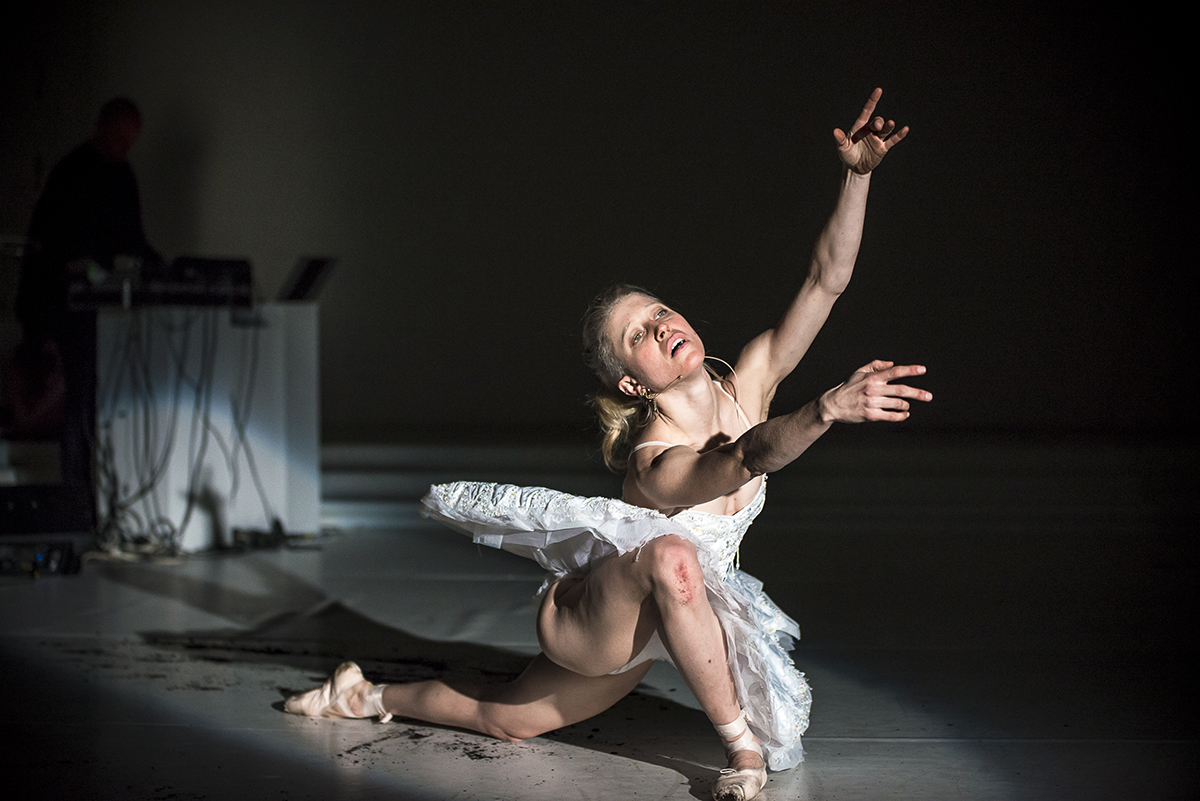
Natalie Abbott, (re)PURPOSE:the MVMNT, photo Gregory Lorenzutti
Completing their entrance, Abbott and Cameron lie face down on a sheet of silvery foil spread on one side of the stage area. The lights change to sepulchral blue and Geoffrey Watson enters through a door at the back of the stage, clomps over to the prone dancers and upends a bag of potting mix. The swans are laid to rest.
But (re)PURPOSE is less about the performance of death itself than the tragic obsession, perverse in a deep cultural sense, with the performance of death by young female dancers. Cameron and Abbott dust themselves off and read a scripted dialogue in which Abbott asks Cameron to kill her in the next scene. Cameron is not keen on this and the two argue. Cameron shouts. She knows what’s going on. She knows what’s happening. And so do we: wicked Madge or some other older woman must liquidate the heroine. This is ballet’s fairytale logic.
Like much recent independent dance in Melbourne, (re)PURPOSE is a loosely organised and thoroughly decentred work that staggers from one suggestive but half-realised performance idea to the next, revelling in dramaturgical disunity and the guilelessness of its own awkward and misconstrued but unmistakably generous invitation.
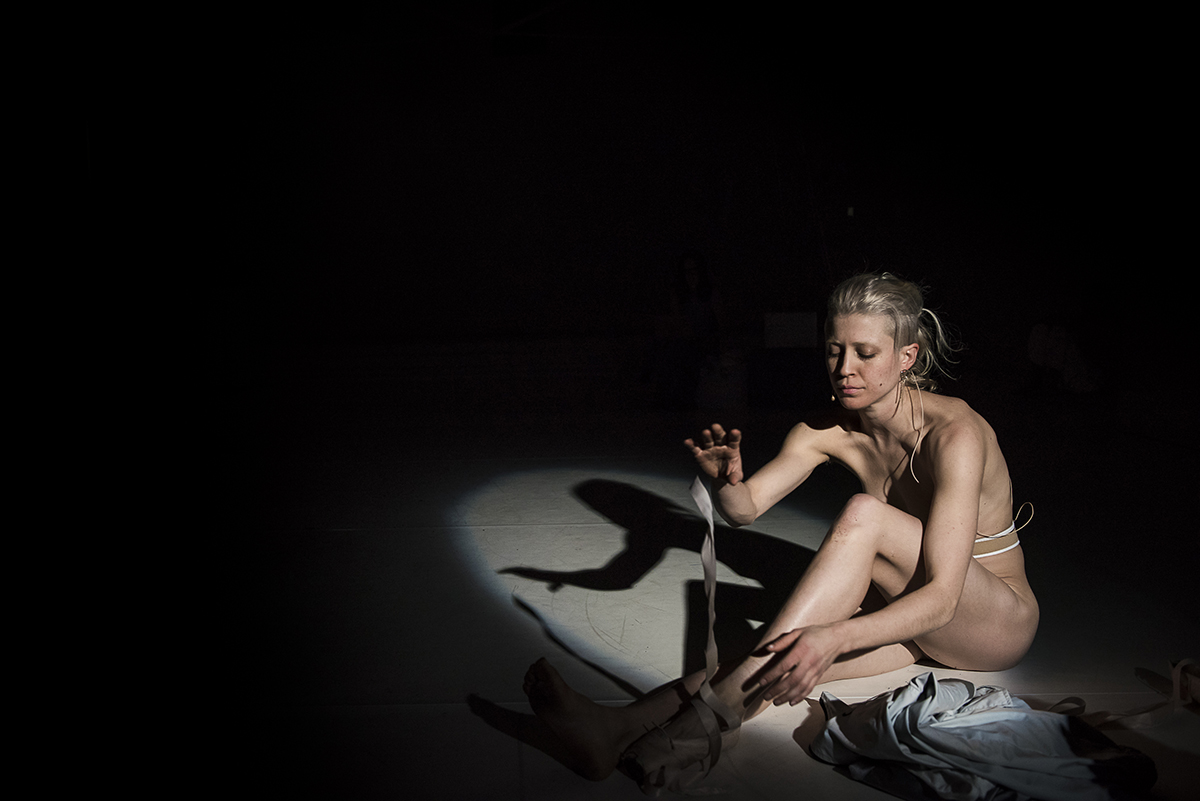
Natalie Abbott, (re)PURPOSE:the MVMNT, photo Gregory Lorenzutti
It is cheerful, but a bit complacent. We are presented with two bodies, but there is nothing immediately striking in the contrast, or in the way the two bodies are orchestrated. There is little of the rigour we saw in MAXIMUM, a work by Abbott from 2014 which examined the different physicality of a female dancer and a male bodybuilder.
It is not Fokine’s Swan that is being danced here, but we do at last catch sight of the familiar ballet, emerging briefly from behind the pile of bright ideas. Abbott climbs into a long white tutu and a pair of pointe shoes and performs a few stuttering bourrées. The lights go down and Watson takes control of a small spotlight and begins haranguing her through a bullhorn.
Yes, there are a lot of props, and a lot of different kinds of performance material, including a transcript of a phone interview with Marilyn Jones, a former principal artist and then Artistic Director of Australian Ballet. But to what end? This is choreography which aspires to the condition of critical apparatus, and yet it struggles to convey the necessary intimate knowledge of history and aesthetics and culture.
–
(re)PURPOSE: the MVMNT, choreographer, performer Natalie Abbott, performers Cheryl Cameron, Crystal Yixuan Xu, Rachael Wisby, Geoffrey Watson, dramaturg Frances Barrett, sound design Miles Brown, Alex Cuffe, lighting design Jonathan Wedgwood; Dancehouse, Melbourne, 5-9 July
Top image credit: Natalie Abbott, Cheryl Cameron, (re)PURPOSE: the MVMNT, photo Gregory Lorenzutti
Good Little Soldier, a work by Australian performance-maker Mark Howett first presented in Berlin and newly staged in Perth by Ochre Contemporary Dance Company and The Farm, deals with post-traumatic stress disorder in soldier veterans. After an opening scene set in an outback kitchen, we are briefly thrown back to Frank’s wartime experience in which he and his comrades capture a woman and a boy. Frank releases the boy to assist his colleague in pinning the woman to the floor. A bomb explodes and only Frank survives. The way in which his own family (wife Trish and son Josh) can be read as his enemies returned to haunt him is thus made clear.
Otherwise the work offers few allusions to either wartime experience itself or to how Frank recalls it. It is rather an exploration of the physical and emotional abuse that he inflicts on his family as a result of his trauma. The focus is therefore quite different from works like Angus Cerini’s Debrief (1999) or the National Theatre of Scotland’s Black Watch (2006), both of which included accounts of battlefield experiences and interviews with veterans about how events were replayed in their memories. One of the most terrifying stories Cerini related was how one man awoke with his hands around his wife’s throat. Good Little Soldier is in this sense an extended dramatisation of such later, domestic events. But what is actually occurring in Frank’s mind, or indeed the others’ minds, is only darkly refracted — rather than explicated — through his abusive behaviour.
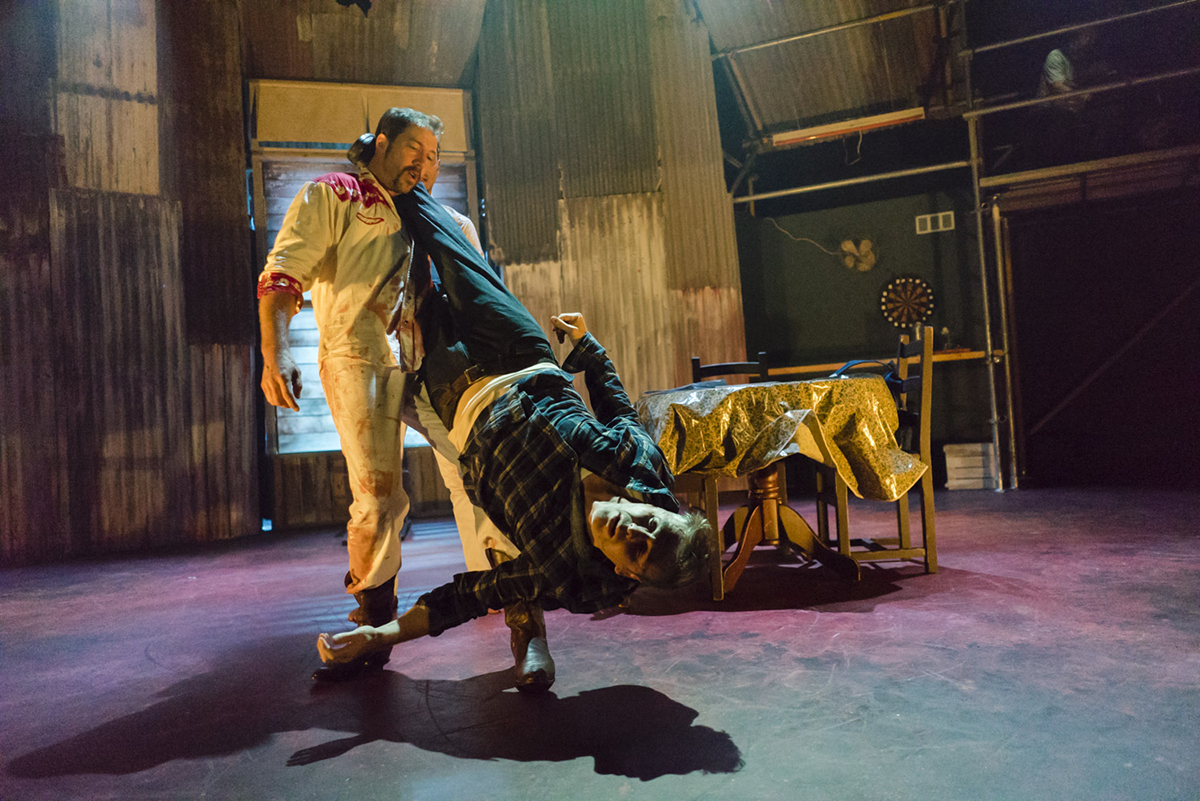
Good Little Soldier, Ochre Contemporary Dance Company & The Farm, photo Peter Tea
The strength of the piece lies in the way it segues between domestic situations which could plausibly be occurring in a ‘real’ world, into unambiguously hallucinatory scenes. Frank is silhouetted against the window as his ghostly, white-attired dead comrades climb down the walls and suspend his squirming body in the air (crawling down walls has been a choreographic trademark of The Farm since Lawn, 2004; watch trailer here). In another striking sequence, Frank, spotlit from above in the darkness, pushes violently against Trish, before she is replaced by each of the ghosts, and then Josh, in a circling wrestling competition that cannot be resolved — the characters endlessly swapping places and matching each other. Choreographically, the piece is dominated by awkward, violent grappling and pushing: a messy rolling and bumping of bodies which form clumsy, writhing piles or temporarily balanced, off-centre structures, before tumbling down. As with Lawn and other works from The Farm, dancers hang off each other from unusual points, such as the head and neck. Faces seem more sites to push fingers into, or to wrap palms across, rather than sites of expressivity.
Good Little Soldier is episodic with each semi-pedestrian set of gestures, or slapping and physical configurations, caught in repetitive cycles. This has a nasty, imprisoned feel to it, but the production is otherwise somewhat flat emotionally. Frank finally raises his hand to strike Josh, and at one point he dons Trish’s dress before slamming himself repeatedly against the wall. These two acts of shocking violence against his loved ones, and, by implication, against himself (to hit Trish is also to hit himself), act as markers within the protagonist’s breakdown. But otherwise the transition from opening to conclusion is horizontal and open-ended. Each scenario is established before being repeated with minor variations, ending with an exhausted collapse, or a character’s departure. Dramatic development within scenes is rare, and their arrangement largely discontinuous. Therefore the affective content depends heavily on the superb music of Dale Couper and Matthew de la Hunty, together with Laurie Sinagra’s sound design — as is consistent with The Farm’s overall multimedia aesthetic.
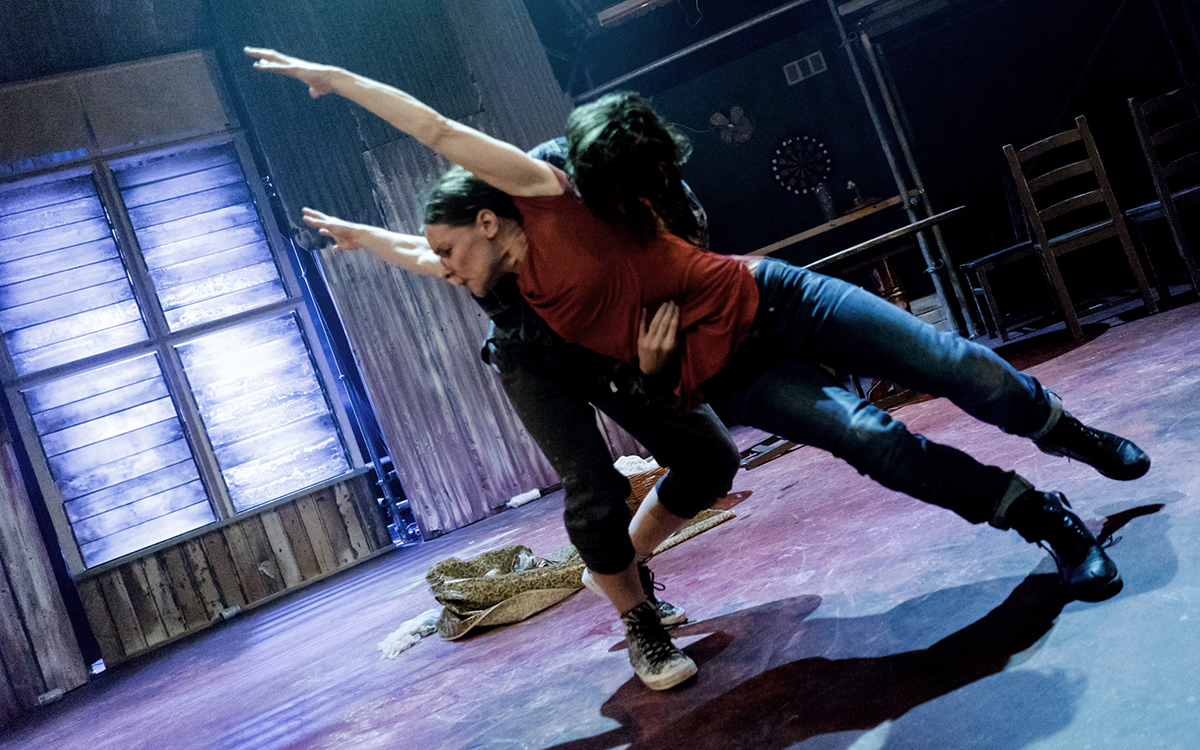
Good Little Soldier, Ochre Contemporary Dance Company & The Farm, photo Peter Tea
Speakers are secreted beneath the seating banks such that leviathanic bass rumbles grind throughout the venue, engulfing audience and performer alike. This sense of the corrugated iron shed which the family inhabits as being something we too are trapped inside, is accentuated by regular entrances and exits through the auditorium, or a moment where a drunken Frank thumps under the seating, asking Trish to let him into the house. Couper and de la Hunty’s immersive score runs from low frequency noise music (signifying the war and moments where Frank slips into trauma), through to pulsing synthesisers recalling 1970s kraut-rock, distorted blues/country-and-western guitar solos, as well as manic junk percussion akin to early Hunters and Collectors (which featured Greg Perano on broken water heaters). The overall effect is like a more than usually theatrical gig from The Birthday Party.
The overall dramaturgy of Good Little Soldier feels at best loose. The expressivity of the work echoes instead the slightly rough aesthetic of the outback-style design, post-punk music and deliberately fumbling choreography. It functions more like a series of related installations. This is arguably the most ‘German’ aspect of the show (referred to by Mark Howett in a RealTime interview), placing it firmly within Hans Thies Lehman’s category of post–dramatic theatre. Good Little Soldier is best seen as a striking collection of thematically related set-pieces, giving the performance an absorbing sense of danger and possibility.
You can watch the Berlin production of Good Little Soldier below:
–
Ochre Contemporary Dance Company & The Farm, Good Little Soldier, concept, direction, lighting Mark Howett, choreography, text, performance Gavin Webber, Grayson Millwood, Ian Wilkes, Raewyn Hill, Otto Kosok, performers, music Dale Couper, Matthew de la Hunty, sound design Laurie Sinagra, dramaturg Phil Thomson, set, costume Bryan Woltjen; Subiaco Arts Centre, Perth, 9-30 July
Top image credit: Good Little Soldier, Ochre Contemporary Dance Company & The Farm, photo Peter Tea
“If you have the ability to create the visual language in which you’re speaking from the ground up, who can say no to that?” asks Denah Johnston, curator of Always Something There to Remind Me, a selection of 16mm experimental shorts from Canyon Cinema that recently screened at ACMI in Melbourne and Revelation Film Festival in Perth. Made by women in the US between 1958 and 2015, the technically, stylistically and thematically diverse films point to the breadth of that period’s avant-garde cinema. Out of this diversity arises Johnston’s interest in the nexus between women and representation, and together the films explore agency, social expectations and the gendered gaze.
Canyon Cinema is a collectively-run distribution company that archives independent films. It started in 1961 with informal screenings projected on a sheet hung in the backyard of the archive’s founder, filmmaker Bruce Baillie, in Canyon, California. Jack Sargeant, Program Director of Revelation, feels the new program of Canyon Cinema shorts “show the importance of the archive and of the curatorial voice, but more than this, they reveal the importance of individual filmmakers who pursue their own visions.”
Kristy Matheson, Senior Film Programmer at ACMI, echoes this motivation to bring rarely seen material to Australian screens. “In terms of a local context, I think it’s essential for female storytellers to be able to access a diverse array of works and this program did just that,” she says. “The range of storytelling devices and techniques shows a great range of work that I would hope inspires female storytellers but most importantly opens up the scope for all viewers to the ambitious and free-ranging scope of female voices.”
New cinematic languages
Johnston explains that she curated this program to highlight how women filmmakers have played with the accepted storytelling language of cinema. “There is such a vast freedom in the form. Obviously they’re not all traditional narratives with three-act structures, and I think that taking a film out of those constraints really works well for a lot of the filmmakers. To make experimental work in the first place you’re already making a conscious and aesthetic decision to step out of the narrative.”
The earliest film is Sara Kathryn Arledge’s What is a Man? (1958), started in 1951 but only completed after her release from psychiatric treatment. It’s a collection of bizarre scenes exploring gender roles, starting with Adam and Eve and moving through to modern mannequins. These are humorous, but also affective, with an emphasis on word play, like the nonsense uttered in the “psy-cry-atrist’s” office.
Sharon Couzin’s Roseblood (1974) illustrates cine-dance, centring on the performance of Carolyn Chave Kaplan. Kaplan’s hypnotic movements are interspersed with a surreal, fragmented series of symbols — flower, knife, eyes, hands. Repetition makes these everyday objects strange, and the kaleidoscopic images, dizzying pace and jarring music produce a mysterious and tense film. This is the most lyrical of the shorts, visually enthralling but also decisively and frustratingly abstruse.
Dorothy Wiley’s Miss Jesus Fries on Grill (1973) invokes a different kind of hypnotic meditation, starting with a newspaper detailing the violent death of Miss Jesus, who was thrown onto a grill when a car ploughed into a restaurant. The narrator muses over this horrifying accident as she tends to her baby, bathing, feeding and watching it fall asleep. Her actions are intimate and also palpably everyday, so different from the very unusual and public accident, and the film is immensely disquieting.
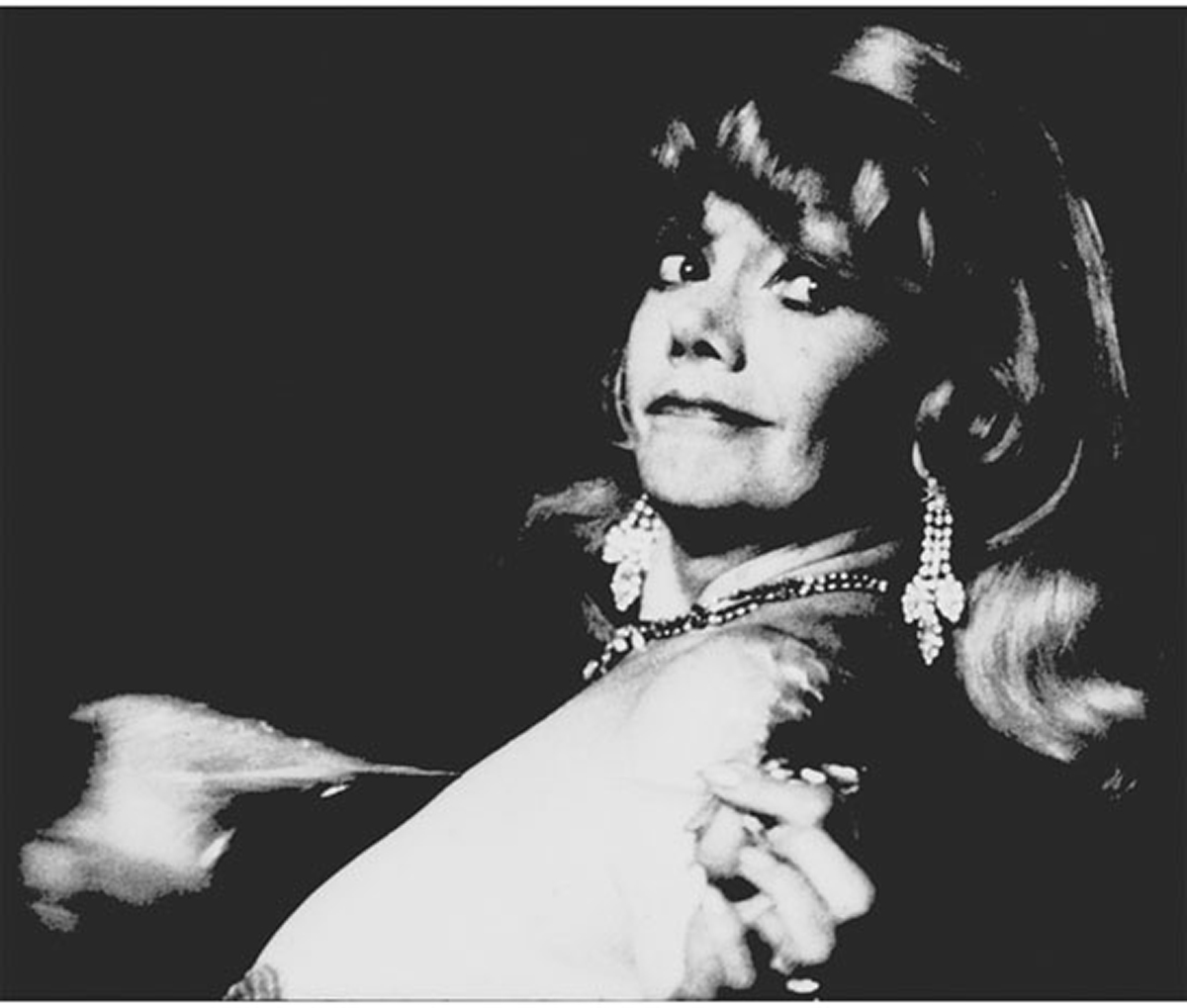
Take Off
Women, through women’s gazes
Three of the films interrogate the idea of women as objects, subverting the scopophilic gaze, a psychoanalytic theory popularised by feminist filmmaker and academic Laura Mulvey in 1976. In a defiantly radical political framework, JoAnn Elam’s Lie Back and Enjoy It (1982) aggressively questions the ways women are represented on screen by men, via a dialogue between a female and a male filmmaker. The dialectic takes priority over image here, which is mostly a flickering close-up of a woman’s face from a black and white pornographic film, distorted through looping, reversing, speed and exposure. In Removed (1999), Naomi Uman also edits a porn film, using nail polish and bleach to erase the female body. The fantasy becomes uncomfortably empty and decisively unerotic. Uman’s film comments on female performativity, in porn and in society, reflecting how identity is manufactured through societal conventions. This is echoed in Gunvor Nelson’s Take Off (1972), which also subverts the male gaze and conventional representations of women. She documents Ellion Ness, a famous burlesque performer, as she stages a striptease, which is conventional until she finishes undressing. When the act should be over, she continues the process in what becomes a surreal disassembling of her body. Ness reduces herself to her parts, as revealed to her expectant audience, but is gleefully in control as she discards the layers.
Chronicles of a Lying Spirit (by Kelly Gabron) (1992), directed by Cauleen Smith, also explores the fabrication of identity, specifically through the lens of her experience as a black woman. An example of Afrofuturism, the film layers time, space and history in following the imagined life of Smith’s alter-ego Kelly Gabron. There is a dual-narration from Gabron and a male voice discussing her in the third person, and the entire story is repeated, prompting a consideration of the instability and unreliability of history.
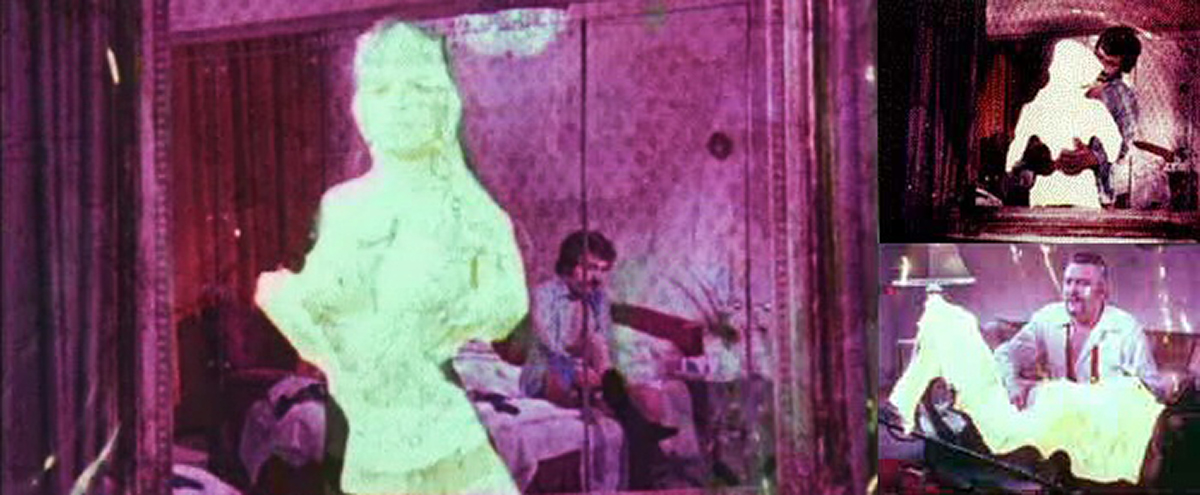
Removed
Collaborative context
Many of the works were collaboratively made and led to further collective activities. Kate McCabe founded the art collective Kidnap Yourself in the town of Joshua Tree, where she discovered inspiration and a creative community. The apocalyptically themed You and I Remain (2015), by McCabe and the collective, is part of the ACMI program. The filmmaker has remarked elsewhere that “you will find more females here behind the camera directing than in the commercial film world and that’s one of the many reasons that field [of experimental film] is vibrant and lush with ideas. The filmmakers I love from the 60s and 70s were breaking new ground.”
JoAnn Elam was also a founding member of Filmgroup (now Chicago Filmmakers) in 1973, which still holds weekly screenings of experimental work. Also in Chicago, Couzin cofounded the Experimental Film Coalition, of which she was president from 1983 to 1988. Some artists collaborated with friends, notably Nelson and Wiley, who made their award-winning first film Schmeerguntz together in 1965, with Nelson revealing that “Dorothy and I needed each other to dare to do it!”
The works are all shaped by socio-cultural discourse and social and professional opportunities offered by second wave feminism, and Johnston draws a comparison between the political consciousness of women filmmakers in the 1970s and today, saying, “right now, I feel like it’s on.”
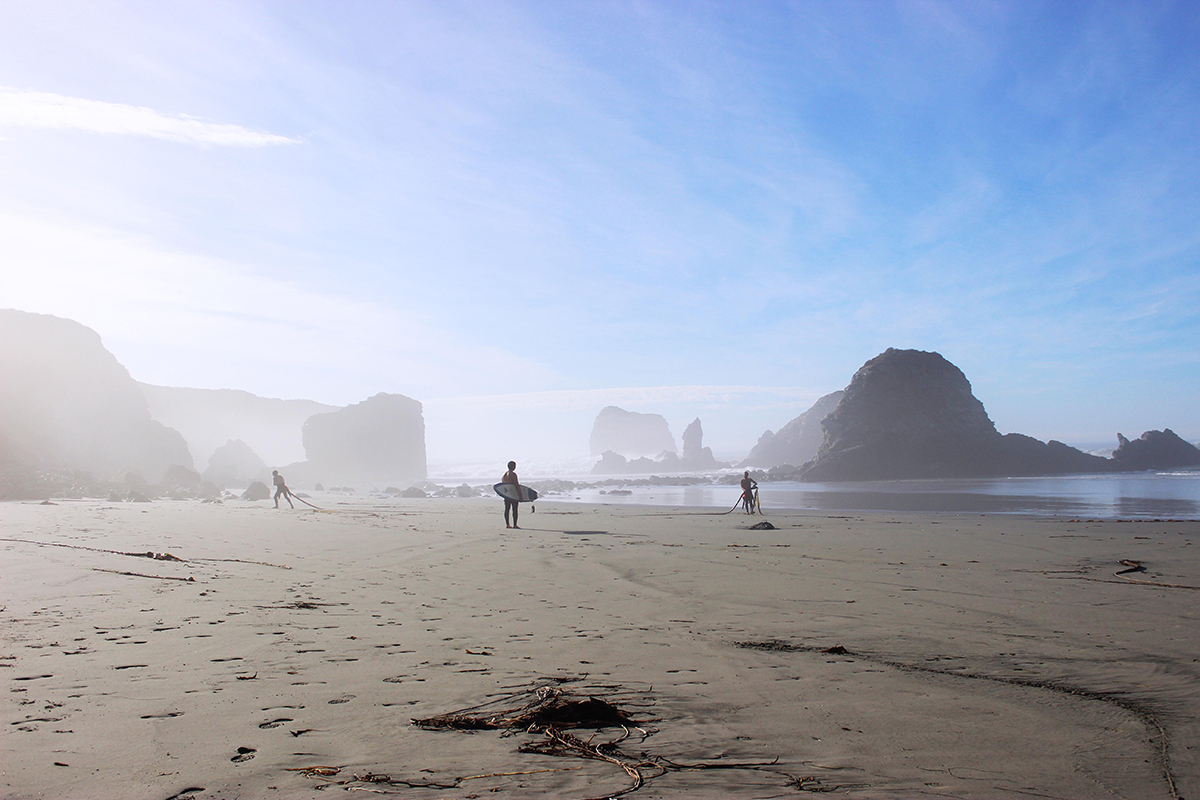
You and I Remain
Local parallels
Tracing these films, there emerge parallels in Australian cinema history, where there was a surge of women filmmakers in the 1970s. Significantly, there was structural support for this, including the Women’s Film Fund (1975-1990), the Experimental Film Fund (1970-1978) and the Sydney Filmmakers Cooperative (1970-1986). There were also collectives like the Sydney Women’s Film Group (1971) and the splinter group Feminist Film Workers (1978) and events like the International Women’s Film Festival (1975).
If much of this government funding has ceased, or at least changed significantly, there continues to be critical — and importantly, public — interest in women filmmakers, with film festivals now providing the backbone of structural support. There are dedicated festivals like For Film’s Sake and Stranger With My Face Festival, which provides mentorship for women developing genre features, while OtherFilm has held several exhibitions and festivals of avant-garde work in Brisbane and at Gertrude Contemporary in Melbourne. Jack Sargeant notes, “this isn’t to say that there shouldn’t be more spaces, more funding or whatever, but there are people making and exhibiting works, so, while the situation could always be improved, I don’t see it as entirely bleak either.”
–
Always Something There to Remind Me, Canyon Cinema retrospective, curator, Denah Johnston, presented by ACMI and Revelation Film Festival, ACMI, Melbourne, 5 July; Perth, 9-18 July
Kate Robertson is a cultural critic with a PhD in Art History & Film Studies, and has written about arts and culture for The Atlantic, Vice, Marie Claire, i-D, Junkee, Overland, 4:3 and Senses of Cinema.
Top image credit: Chronicles of a Lying Spirit
We all play roles in our work and home lives and often are assigned these in childhood by our family. We are the ‘bossy one,’ ‘the baby,’ or ‘the black sheep.’ These roles trail us into adulthood and they become our default setting when we are faced with big events — cataclysmic grief, heady love and loss. The roles we are all cast to play both conceal and reveal us.
Enter the self-proclaimed ‘comical woman,’ a part both played and railed against in He Dreamed a Train and Eve, the double bill from inimitable Brisbane theatre maker Margi Brown Ash.
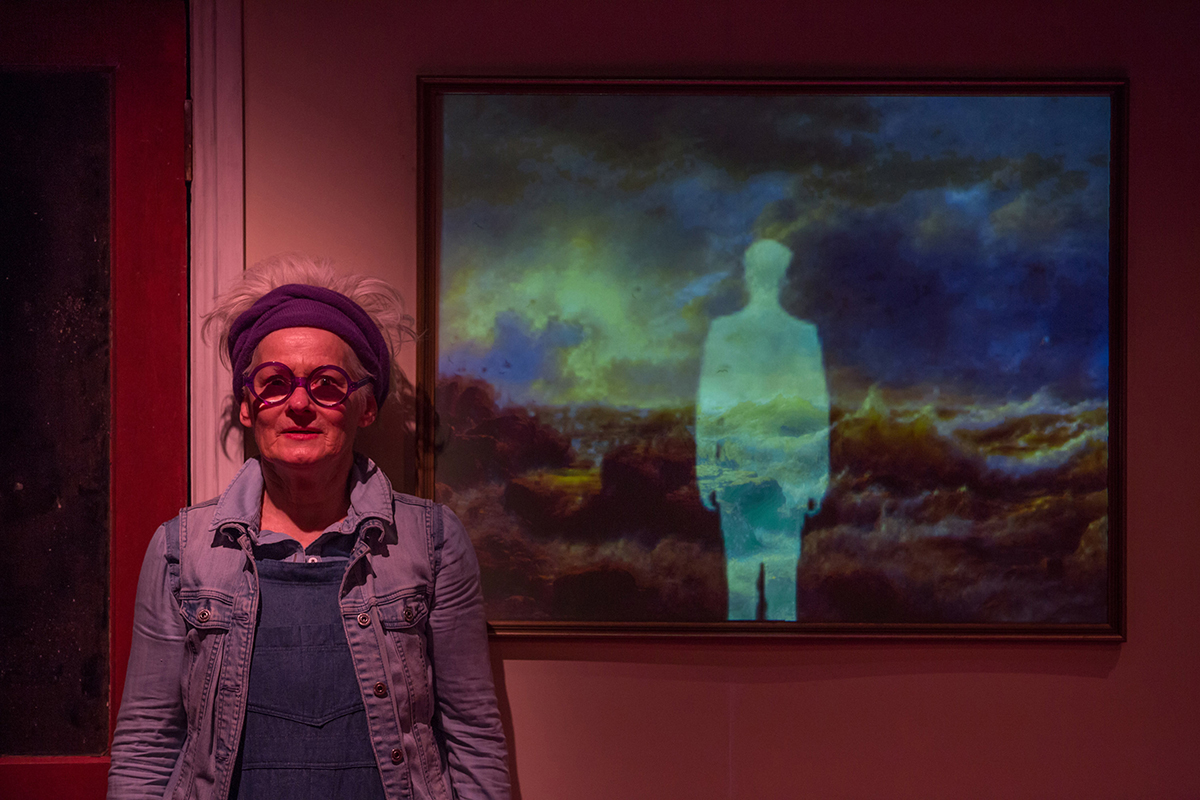
He Dreamed a Train, Margi Brown Ash, photo Stephen Henry Photography
He Dreamed a Train
He Dreamed a Train, directed by Benjamin Knapton, is a paean to a loved brother and an intimate encounter with one family’s experience of loss. The work is inspired by real events — the degenerative neurological disease that prematurely claimed the life of Margi Brown Ash’s brother. We are warmly invited to bear witness to her grief, and share in it too.
The show opens when the bereft narrator, Margi, returns to the family home, to pack up her brother’s belongings and excavate old memories, perhaps in order to make some sense of the tragedy to herself. There are still things she has to say to him.
The brother presents as a dreamer type. He is visionary at times — his idea to revitalise regional communities by linking them with a monorail holds a kind of wacky genius appeal. Yet he infuriates in his refusal to accept treatment or find ways to stymie the onset of his symptoms.
Margi tells us what she cannot say to him: that if it were she who was sick, she would try everything — yoga, Pilates, acupuncture, the works — to stave off illness. This treads the line of the tragicomical, sort of like drinking a green juice to combat cancer; it might help, but it does not address the larger issue. When those you love are dying, there are conversations that are just too difficult to have. Instead we try to fix things through action, in this case with helpful suggestions for alternative therapies.

He Dreamed a Train, Travis Ash, Margi Brown Ash, photo Stephen Henry Photography
The set is comforting; it could be any one of our lounge rooms and we are lulled by its familiarity. Except of course for a lone picture on the wall. A seemingly innocuous sky scene, one might find in an old opp shop, becomes a beautiful digital image, evoking Brown Ash’s emotional landscape. Just as what remains unsaid builds in momentum, the painting is a living artwork throughout: the clouds rain, the heavens open, the sky bleeds down the wall.
Time jumps into the childhood home where the characters are visited by their younger selves, entertaining each other with mythological tales, dragon legends and their own creation stories. The most potent of these are train moments — the children playing chicken in a train tunnel, a family legend which becomes significant later in the work.
But the grieving sister cannot stay silent in the end and refuses to be diverted by these ghosts. At one point Brown Ash demands to speak not with the 25-year-old version of her brother, charmingly rendered by performer and musician Travis Ash, but “the sick old man” who has let them all down by dying too young. Her anger in this moment is palpable and affecting. The ‘comical woman’ has been cast aside. This is the kind of role that floats away like vapour when there is no one left to play with.
Yet all families have creation myths, stories we tell and retell. In them, no one dies, not really. The lost loved one is always there, just behind the clouds in the picture on the wall.
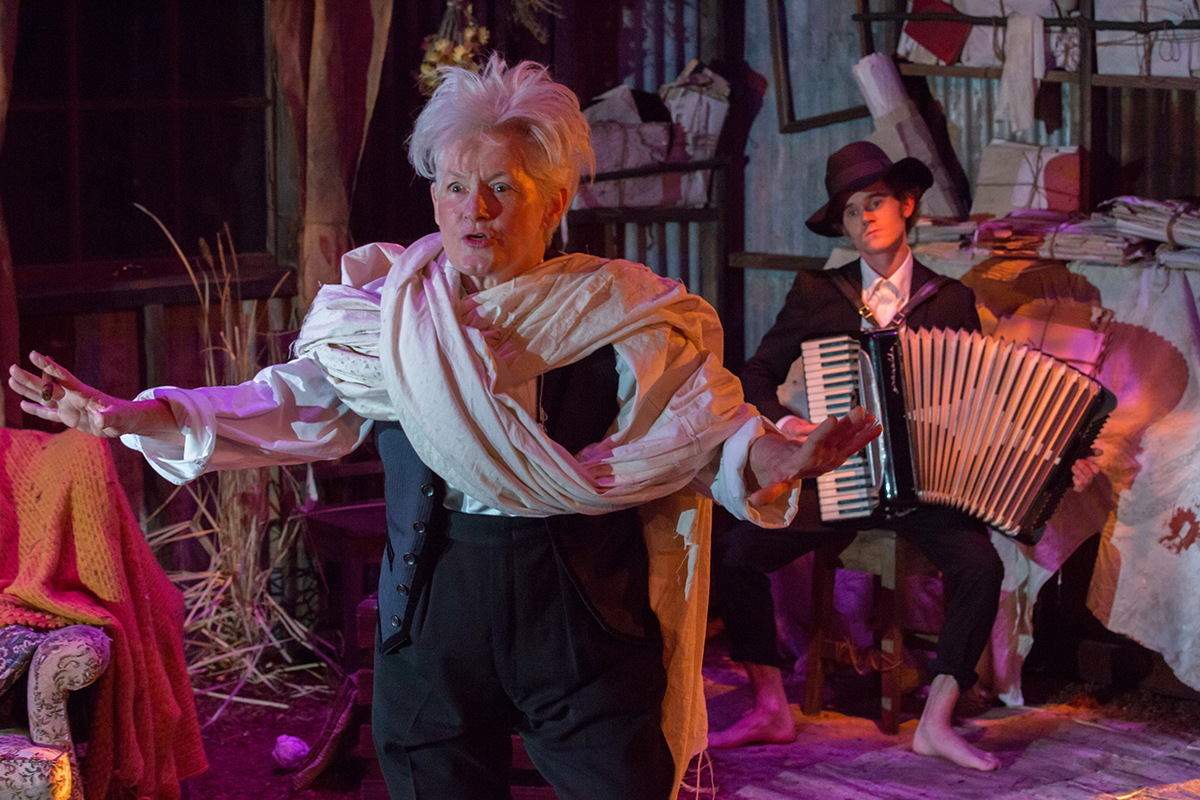
Eve, Margi Brown Ash, Travis Ash, photo Stephen Henry Photography
Eve
Eve, which was first staged in 2012 and is directed by co-devisor Leah Mercer, sees another figure struggling with the roles she is expected to embody. This show is a gloriously exuberant ‘biopic’ of the life of Australian novelist and poet Eve Langley (1904-1974), billed in the program as Australia’s answer to Virginia Woolf. This time, Brown Ash as Eve ricochets between the roles of ‘brilliant writer’ and ‘wife and mother,’ delivering moments of humour and pathos in equal measure.
We first see Eve banging away furiously on her typewriter in an iron tub in a bathroom open to the elements: a kind of a lean-to off her bush hut. She appears to be hiding out from the prosaic demands of her husband and small children, snatching precious moments with the muses where she can.
Margi Brown Ash draws on the artist’s published and unpublished writings to offer us a glimpse into the cosmos that is Langley’s interior world. In this makeshift room of her own, Eve dips deftly in and out of bush poetry, religion, astronomy and mythology. Her mind is nimble, and her ability to weave together these tangents to create vivid and startling imagery, gives us an insight into its dazzling velocity. Brown Ash’s performance of these excerpts matches the verve and wit of Langley’s writing.
As Eve works in the bath, manuscripts tied with string drop with a thud from the ceiling. We are lovingly introduced to these works as if they are her children. However, some of these parcels contain rejection slips. We also learn Langley was a furious correspondent, hilariously advising booksellers that she is happy to accept returned manuscripts only if addressed to Oscar Wilde, since he could ostensibly handle them better than she. Her acerbic sense of humour is highlighted; the ‘comic woman’ is a role Langley evidently both played and downplayed. She wears a topee hat, men’s strides and appears to cultivate a wild bush raconteur’s demeanour. Humour is her way of handling what cuts her to the quick, yet Eve longs to be recognised as more than amusing.
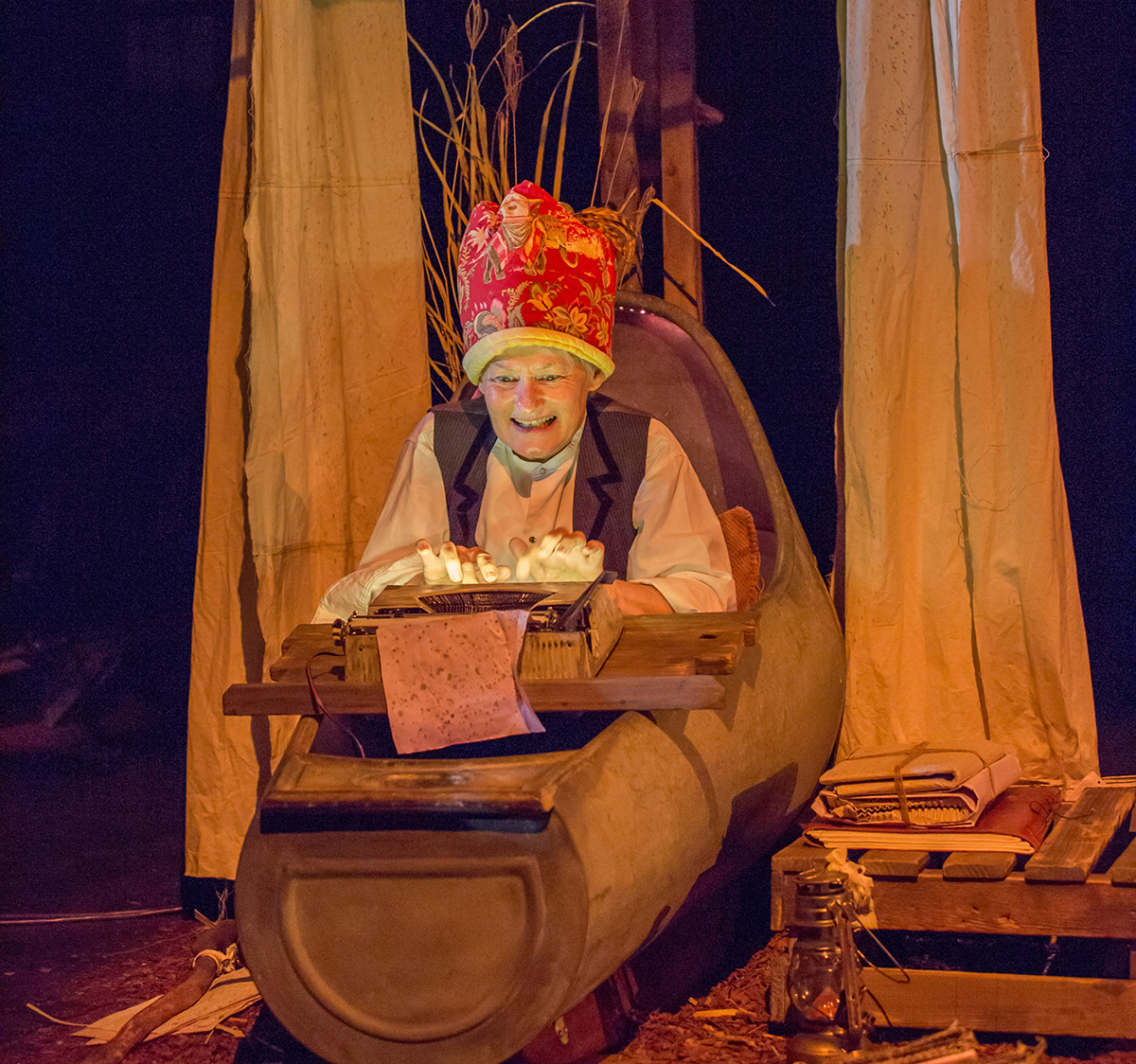
Eve, Margi Brown Ash, photo Stephen Henry Photography
Perhaps it is the rejections that prompt Eve to return to her domestic role and its responsibilities for a time. After a spate of creativity, we see her cross the threshold into her home proper. In this role she is less successful, although she does try. Eve’s mind shrinks, not soars. The detailing of the set, designed by Aaron Barton, is incredible, evoking the sort of household objects and collectibles found in a Margaret Olley painting. But all this is a distraction for Eve, just more stuff crowding her already busy brain. Domestic miscellany is too much in the end, or perhaps not enough. The artist cannot deny her true self and write she must, drink in hand all through the night and even as the sun rises, family be damned. In this retelling, Eve solves her childcare problem by upending her babies on the mantelpiece. By standing them on their heads, she reasons, they cannot fall — genius in its madness. Her husband has her committed to a mental hospital, nonetheless.
After her release, Eve continues to write, though she will struggle with the duality of these roles for the rest of her life. Ironically it is her adult children who, upon their mother’s death, discover a cache of Langley’s writing secreted away under her bed, as Emily Dickinson had done. It is they who marvel at her words, her true essence, concealed for so long and they who vindicate past neglect.
As a woman writing at a time where the roles of ‘wife and mother’ and ‘artist’ were often seen as mutually exclusive, Eve explores the theatre of playing house while needing to create and inhabit other imaginative worlds. The tragedy of Eve Langley’s life was not that she was denying her true self — the artist was fully aware that she needed her writing to ground herself. She had two great loves, her family and her work, but it was demanded that one be chosen at the expense of the other.
Eve and He Dreamed a Train are linked thematically by their bush settings, their artful tapestry of mythology and personal story and by Margi Brown Ash’s disarming impulse to stop for a cup of tea mid-show. We too are invited to pause and consider the roles we play, to look through and break out of them. That is the great, generous gift of Margi Brown Ash in works, crafted with skill and love.
–
Force of Circumstance, Nest Ensemble & Brisbane Powerhouse: He Dreamed a Train, writer, performer Margi Brown Ash, director, set & AV designer Benjamin Knapton, performer, sound designer Travis Ash, A/V content Nathan Sibthorpe, lighting designer Geoff Squires; Eve, writer, co-deviser Margi Brown Ash, director, co-deviser Leah Mercer, co-deviser Daniel Evans, performers Margi Brown Ash, Travis Ash, design Aaron Barton, costume designer Bev Jensen, sound designer Travis Ash, lighting designer Geoff Squires; Brisbane Powerhouse, 2-16 July
Victoria Carless is a writer living in Brisbane. Her first novel, The Dream Walker, was published by Hachette Australia in July.
Top image credit: Margi Brown Ash, Travis Ash, Eve, photo Stephen Henry Photography
Garry Stewart’s visceral and intellectually provocative Be Your Self plays in Melbourne 2-5 August prior to a wide-ranging ADT tour. Watch this 2012 realtime tv interview with excerpts from the performance.
Sadly, Tony Woods, a highly inventive Australian visual artist whose films and light-filled paintings we have long admired, died unexpectedly in June. In 2013 we published a review of Tony Woods: Archive in which writer Danni Zuvela described the work of this important Australian artist:
“Invited to muse on the aesthetic and conceptual relations between the artist’s practice across canvas, celluloid, pixels and audio tape, we start to develop insights into how the dialectic of representation and abstraction powers an artist like Tony Woods, finding varied expression across forms, materials and decades.”
Tony Woods: Archive is a wonderful record of the life and work of this much-loved Australian contemporary artist. It’s published by www.artinfo.com.au and distributed by Australian Scholarly Publishing (ASP).
The book includes a richly informative 55-minute DVD of the documentary Tony Woods: Work for the eyes to do, which you can see below. Or you can watch a 20-minute summary of Woods’ life and art currently posted as a tribute to the artist on his website.
Virginia & Keith
–
Top image credit: 1994 same chair changed light situation, oil on canvas, Tony Woods: Archive, image courtesy the artist
Thai-Australian playwright Disapol Savetsila’s Australian Graffiti has its moments: flashes of crisp, acerbic dialogue, grim physical comedy, occasional deft character delineation, vivid arguments and some emotionally sensitive exchanges. It’s otherwise underdone — character development is limited, critical motivation unexamined and the tonal shifts in language and mood between the scenes with and without a ghost character are minimal in the play’s easy-going naturalism, despite a press release claim for its “magical realism.” For real magic you need to turn to Apichatpong Weerasethakul’s Uncle Boonmee Who Can Recall His Past Lives, winner of the Palme d’Or at the 2010 Cannes Film Festival, in which ghosts can slip in and out of the world with unnerving effect.
Faults aside, Australian Graffiti warrants attention since Savetsila is another in a number of new culturally diverse voices coming to Australian stages and performance spaces and needs to be heard, not least for the essentially dark vision entailed in his story of Thai-Australian business failure compounded by Australian racism and traditional Thai attitudes to filial duty. For all of its leavening comic moments, the play offers at its end only a sliver of hope for cross-cultural conciliation.
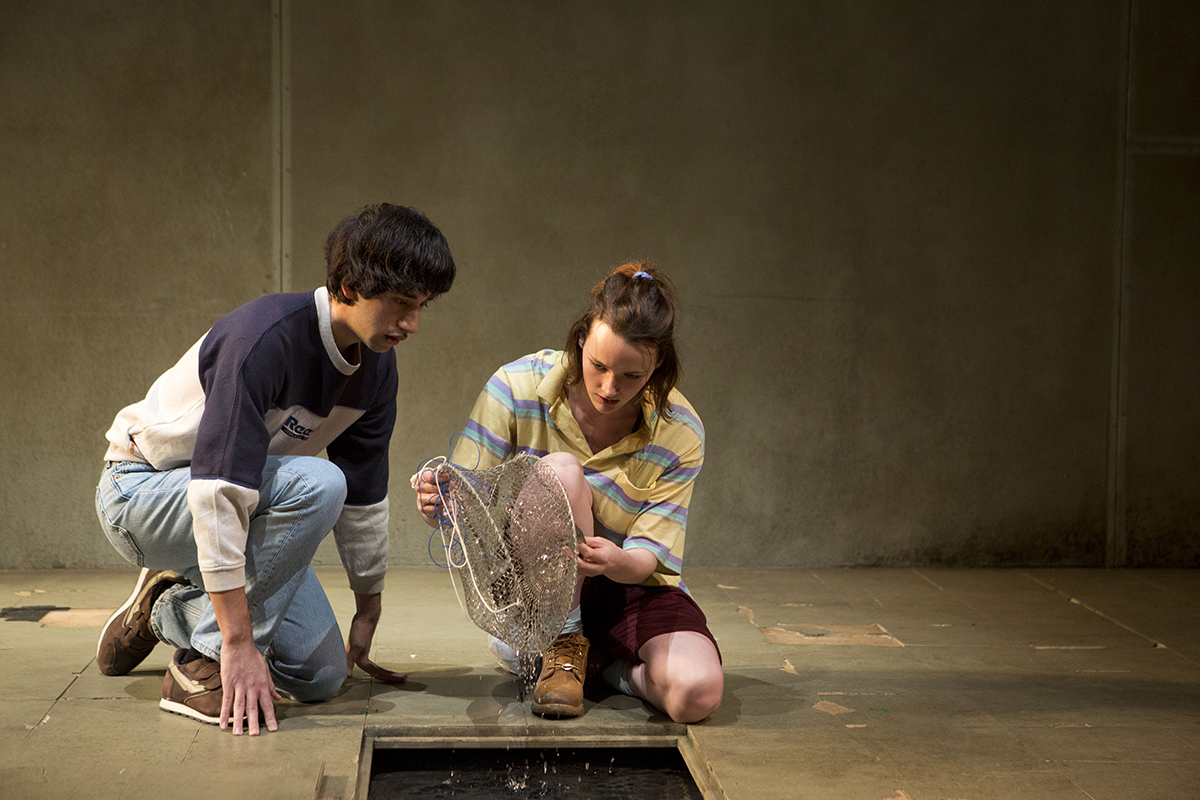
Mason Phoumirath, Airlie Dodds, Australian Graffiti, Sydney Theatre Company, photo Lisa Tomasetti
Amiable chef Loong (Srisacd Sacdpraseuth) has died — his body heartlessly lugged about by the play’s other characters in bouts of black comedy — but visits as a ghost, encouraging those who listen that there is life beyond a failing Thai restaurant in a regional Australian town. The elegantly dictatorial Baa (Gabrielle Chan) continues to run the business with a ruthless work ethic, regardless of the absence of customers. Illegal immigrants — boisterous, despairing Boi (Kenneth Moraleda) and the more hopeful but ill Nam (Monica Sayers) — have become Loong’s replacements, but are not good cooks (they desperately experiment with Vegemite dumplings). Moving the business from town to town has forced home education and separation from his peers on Baa’s lonely, intelligent adolescent son and waiter Ben (Mason Phoumirath). However, a chance meeting by a creek introduces Ben to Gabby (Airlie Dodds), a caustic, tough-minded white Australian of his own age who introduces him to yabbying. This is where the play opens with youthful banter and marked sexual attraction, although Gabby drolly mocks the idea of a relationship tainted “with the stigma of sweatshop labour.”
There’s a bitter edge to joking in Australian Graffiti. Gabby’s father (Peter Kowitz), a nasty character of the bullying Australian “can’t you take a joke” variety grows angry when humour is directed at him: “You speak good English,” he says to Ben, who retorts, “So do you.”
Ben and Gabby’s meeting at the play’s end will be a test whether or not Ben can continue the relationship with the only friend he has ever made (if barely so) and if Gabby can separate herself from the racism of her policeman father and the townspeople. After their first meeting, she’s been resolutely hostile, feeling — because of Thai graffiti appearing on a church altar wall — that Ben and family have turned her private paradise into a hell. It’s not much of a town, but it’s hers, she declares with passionate conviction in one of the play’s stronger moments. But there’s little to indicate in the course of the play that she’s capable of the insights that come at its end. Ben, more convincingly, is determined to develop the friendship and break free from the restaurant and his mother’s insistence on gratitude for her sacrifices (“I’m building an empire for you!”). A girl and a ghost draw him out of a smothering cocoon which he knows has never been ‘home,’ although the options for him to remain in the town seem profoundly limited as his mother moves on.
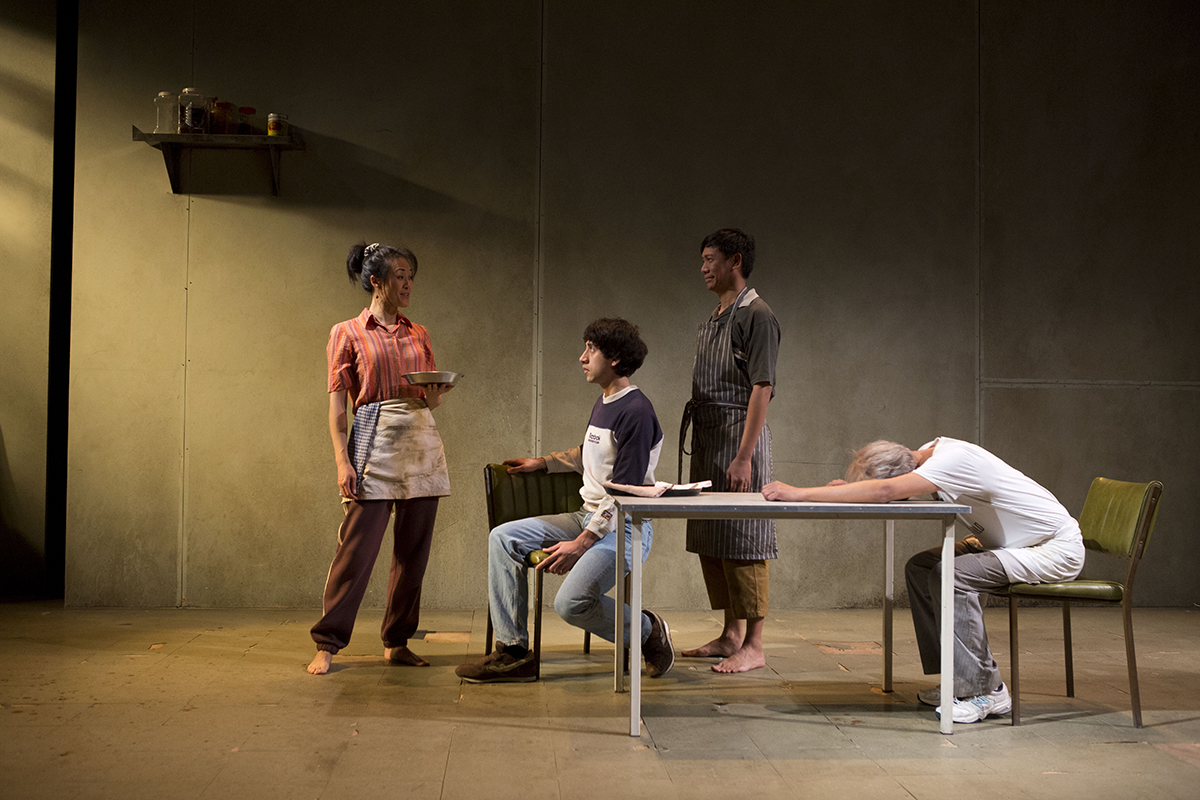
Australian Graffiti, Sydney Theatre Company, photo Lisa Tomasetti
The executor of the graffiti is finally revealed and the symbols translated, but the meaning is enigmatic and the motivation behind it left infuriatingly unexplained — an opportunity lost to deepen both a character and the possibility for shared understanding between cultures in conflict. Why might someone be driven to commit such an act? It also prompts the question, why Australian Grafitti? Is it ironic? The graffiti in the play is Thai, it spoils and desecrates, but the disproportionate response (Ben accused, the violence, banishment in effect) and unleashed racism could be seen as graffiti writ large on the immigrant body.
One of the strongest images in the play is of a small girl who is sighted recurrently peering into the restaurant until, with her black eyes, she becomes a frightening apparition for the nervy Boi, racism incarnate. A crowd forms, rocks are hurled, windows broken and we learn later Gabby was one of the perpetrators. Other moments linger: Loong’s enticing Ben to relish the freedom inherent in eating fresh mango and his wise discourse on entrapment with the metaphor of dogs happily fattened up to be eaten: “suicide by food,” he quips. His admission, “All I have is hindsight,” is one the play’s best from Srisacd Sacdpraseuth’s engagingly realised ghost character, who grumpily complains to Nam that when he was dying, her over-vigorous CPR broke a rib. His funeral, after days of lying about and ritually held in the restaurant building for fear of alerting authorities to the presence of illegal immigrants, becomes an aptly incendiary affair for a sower of doubt.
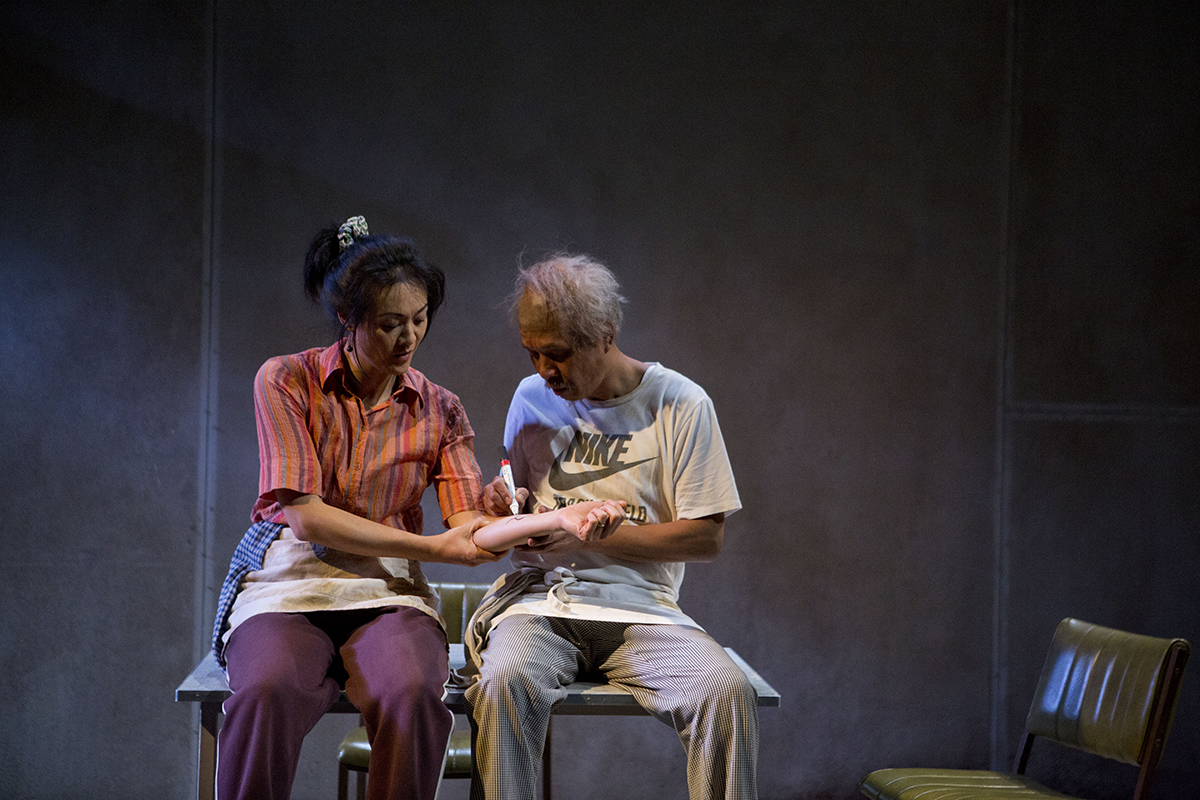
Monica Sayers, Srisacd Sacdpraseuth, Australian Graffiti, Sydney Theatre Company, photo Lisa Tomasetti
Australian Graffiti’s limitations were underlined by a large, high-walled greyish, fluoro-lit set (representing a room adjoining the unseen restaurant) that, although amplifying Ben’s sense of homelessness, reduced the sense of intimacy and entrapment felt in the writing and produced, at times, over-projection from some of the performers (a late reference to the room as a former ballet studio didn’t compensate).
Despite its occasional strengths and strong performances, Australian Graffiti’s appearance on an STC stage was clearly premature. It’s not without promise, but Disapol Savetsila deserves dramaturgy that will address the gaps in the work and opportunities to follow through on the complexities he conjures.
–
Sydney Theatre Company, Australian Graffiti, writer Disapol Savetsila, director Paige Rattray, performers Gabrielle Chan, Airlie Dodds, Peter Kowitz, Kenneth Moraleda, Mason Phoumirath, Srisacd Sacdpraseuth, Monica Sayers, designer David Fleischer, lighting designer Sian James-Holland, composer Max Lyandvert, sound designer Michael Toisuta; Wharf 2, Sydney, 7 July-12 Aug
Top image credit: Australian Graffiti, Sydney Theatre Company, photo Lisa Tomasetti
Upon The Babadook’s release in 2014, Katerina Sakkas wrote in RealTime that “the most powerful horror films are underscored by reality, presenting recognisable fears and anxieties in magnified and fantastic form.” Indeed, writer-director Jennifer Kent’s debut is a haunted-house horror film of folkloric dimensions and feminist temperament, in which a family home harbours the unspoken terrors and taboos of parenthood. A small boy’s beloved storybook monster morphs into a far more sinister organism, a long-fingered, top-hatted creature called The Babadook that torments his mother, who is in the throes of grieving her partner’s death.
Three copies courtesy of Umbrella Entertainment.
Email us at giveaways [at] realtimearts.net by 5pm 2 August with your name, postal address and phone number to be in the running.
Include ‘Giveaway’ and the name of the item in the subject line.
Giveaways are open to RealTime subscribers only. By entering this giveaway you consent to receiving our free weekly E-dition. You can unsubscribe at any time.
On the occasion of our DVD giveaway of The Babadook, already recognised as a canonical Australian horror film, we revisit Katerina Sakkas’ illuminating interview with director Jennifer Kent.
So much of contemporary life feels as if it’s shattering. In the art ecology, the labour market, the housing sector, media business models and politics, things aren’t working like they used to. But sparks of fresh life are coming from surprising places. Ancient sky spirits speak to us in Warwick Thornton’s documentary, fresh from the festival circuit. Perth theatremakers are breaking apart the very atoms of narrative and putting them back together in weird and inventive ways. In a renovated substation in Melbourne, Angelo Badalamenti’s 25-year-old Twin Peaks soundtrack is remade by an art-rock band. And we continue our series of video essays by Conor Bateman — RealTime is the only publication in Australia to consistently commission such audiovisual works, as part of our effort to find new means to bring words and images together in works of creative criticism. The old ways are gone, but glimpses of the new are all around. LCH
–
Top image credit: We Don’t Need A Map
Warwick Thornton entered cinema’s global attention in 2009 when his debut feature film, Samson and Delilah, won the Camera D’or prize at Cannes Film Festival, but his presence has been long felt in the Australian creative community in many capacities — as cinematographer for Rachel Perkins’ Radiance (1998), as a photographer and conceptual artist exhibiting at such spaces as ACMI and Stills Gallery, and now as a documentary-maker. Earlier this year, Thornton’s We Don’t Need A Map was the bold choice for opening night at Sydney Film Festival (whose program dwelled heavily on issues of race) and this month broadcasts on NITV.
The film takes the Southern Cross as its focus. Unbeknown to those who tattoo it on their shoulders and fly it on their flags as a symbol of nationalist pride, the constellation has its own myriad significances for Indigenous Australians, whose knowledge of astronomy is a form of mapping, ritual, storytelling and moral education, that exist as one with stories of country. Thornton takes us away from the city and into a number of Aboriginal nations, to hear elders tell their culture’s story of the great constellation, which turns out to be a crucial wellspring in creation lore. Along the way, we also hear from academics and artists, offering a 360-degree viewpoint on what the Southern Cross means when stripped of its exclusionary and muddle-headed political connotations.
Press materials describe the film as a punk roadtrip doco, with irreverent sequences involving bushranger puppets and dioramas, but it has much broader implications: Australia has a problem relating to the past, as if history has only recently arrived young and free in this most ancient continent, and Thornton proves himself a forensic dissector of the myths, delusions and rhetoric that dominate the history wars from the Eureka Stockade to the Cronulla riots, to today. His vision is a long-sighted one, grounded in ancient protocol and law and faithful to fact and history in a way that both reveals and respects the secrecy of Indigenous, pre-industrial knowledge, while also showcasing the insights and wisdom of some remarkable non-indigenous Australians.
LCH I learned heaps from this documentary. The image of the Southern Cross constellation reflected in the side mirror of a car door seemed to me to be a great visual symbol of the film’s approach. What’s your impression of the film?
TY That reflected image idea is a big part of the knowledge Thornton is working with. In our cultures Skycamp in many ways is a reflection of the earth, with sites, stories and songlines in an “as above so below” kind of arrangement, stemming from the Turnaround event of creation that separated the material and spirit worlds into earth and sky. They reflect each other, overlapping at sacred sites and through the kind of ritual practice that is depicted in the film. An image of a person or entity is sacred because it holds the spirit of that thing — so the word for spirit and image is often the same in our languages. This is the reason we often avoid images and names of the deceased. It is the same reason the old men in the film erase the Southern Cross symbol following the ritual.
LCH To me the doco spoke to how symbolism can be twisted and mutated. It made me realise that nationalist usage of the Southern Cross in contemporary Australia is the most grotesque form of cultural appropriation. What are your thoughts on this?
TY As the old men said, that image is sacred and cannot be kept; it certainly cannot be marked on the body outside of ceremony. The people who adopted the Southern Cross image for flags and tattoos as a symbol of nationalism based on exclusion and privilege are really cursing themselves and their own people, from this perspective. But it is simplistic to frame this as a “white” thing, or Australian thing, and I think the film explores this in a more nuanced way. I was particularly struck by the switched-on Anglo people who were interviewed — their self-awareness and critical reflection are a credit to them and their community. No denial or defensiveness — their level of awareness and perception in critiquing their own culture is a great strength and does not diminish them — it makes them complete people. They are comfortable with discomfort and committed to truth as a way of life. They set a good example for others to follow. Duane Hamacher, for example, who is interviewed at a stone calendar site at the beginning of the film, has done exciting work in this field.
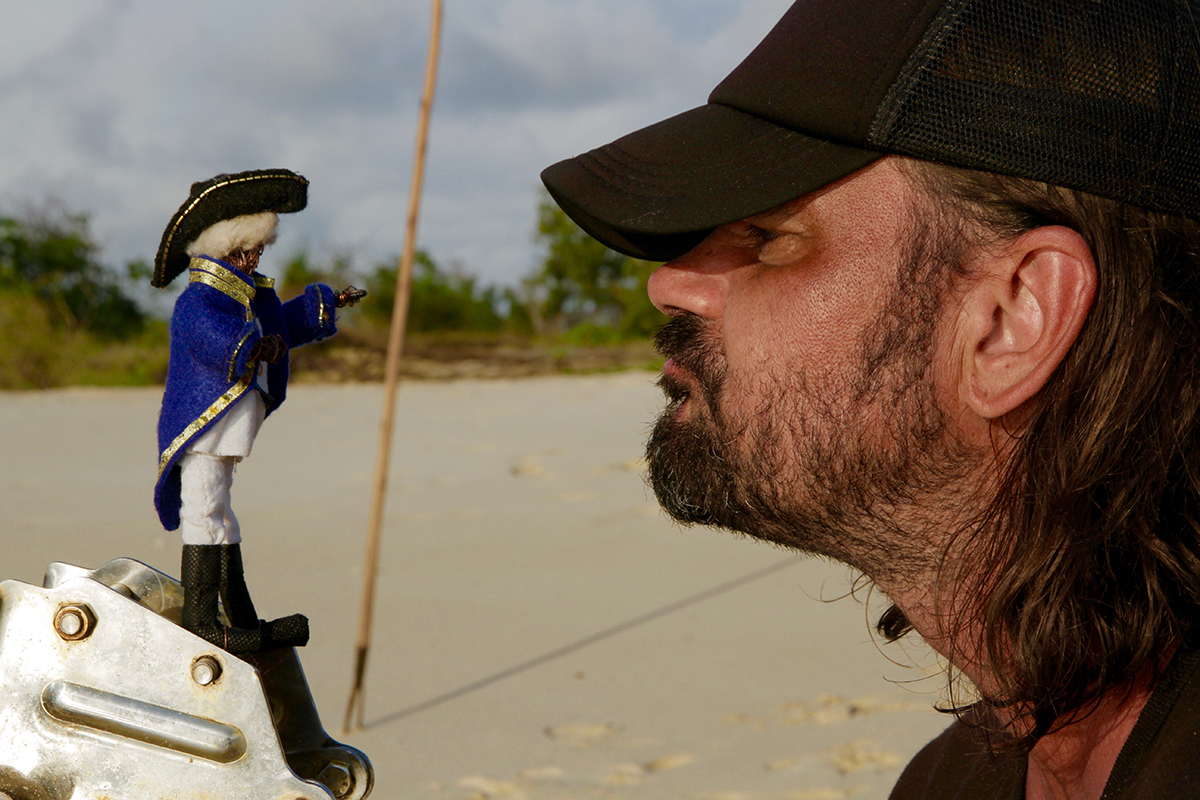
We Don’t Need A Map
LCH It is fascinating to learn more about Indigenous astronomy, which has an understanding of the negative spaces between stars. Thornton describes it as not just being about navigation, but interviews someone who says, “the night sky, for us, was the whole of philosophy.” As one of the elders says, “all these stars are connected to all these trees,” and all the stars are related, too, rather than being carved into discrete, lonely constellations.
TY The idea of astronomy as a mere navigation tool is very industrial and utilitarian, and our star knowledge goes way beyond that. All the memories are up there in the stars — the night sky is a vast mnemonic device that is used to store terabytes of knowledge. These memory maps are used to navigate mind and memory over deep time, to hold ancestral knowledge so vast that it would be impossible to contain in print. This knowledge is also held in songlines all across the land, and in inner maps held in the mind, so they can be accessed without actually being in the place or even looking at the sky. This is our literature in oral cultures, and it was the same for everybody in the world until very recently in human history. You can see it in the early works of Western literature, like Homer’s epics, which were oral texts initially before being written down. This orientation to knowledge and memory results in a way of knowing that some people call “pattern thinking,” which modern science is now exploring through complexity theory and fractals; it allows us to see the whole as well as the parts and discern patterns in what some see as chaos, to make accurate predictions about weather systems and human behaviour. Some of us are even currently applying this Indigenous reasoning to economic trend analysis (and let me tell you, the outlook for the near future doesn’t look good!).
LCH The film talks about how the Southern Cross connects land and sky stories. Is there any information embedded in the film that an audience member without deep Indigenous knowledge would miss?
TY That information is present, but difficult to see through a Western lens, particularly a perspective based on binary oppositions — male/female, light/dark, land/water, heaven/earth. It is all about the connectedness and transformative overlap between things that some see as opposite, the vast songlines that connect freshwater to saltwater, Skycamp to earth, men to women. The inland stories are connected to coastal stories, and these are stories of transformation and transition. There is also lots of latent information embedded in the film about women’s business and men’s business. With the canoe ritual in the film we see the common overlap between the two — when the old lady is singing we glimpse the power of women’s knowledge and the old matriarchal authority, the edge of it where it overlaps in a common space that can be accessed by all the community. The rest is so secret and so powerful — you’ll notice the women do not share with Thornton beyond this. The power and agency of women in our culture is seldom acknowledged in the mainstream — the Western lens frames us as patriarchal and abusive when it comes to gender relations. That’s the binary thinking again.
LCH I don’t think that mainstream Australia really understands that Indigenous custodianship and care extends from the land through the air to the sky — that’s the extent of colonialism’s theft, too. Do you think We Don’t Need a Map conveys the expanse of Indigenous ecology and thinking, this sense of a galactic robbery?
TY This is not just Indigenous knowledge, but human knowledge that all people had until recently. Industrialised and colonial thought is imposed and kept in place through a kind of cultural brainwashing, disconnecting people from what they really are. It is not as simple as black and white — it is about industrial and non-industrial reasoning. Scratch the surface and you’ll find that all around the world people all call the Seven Sisters constellation the same thing, with a similar story. Orion is always a hunter or warrior. Castor and Pollux are always two brothers. Aquila is always an eagle. All people globally are connected to these songlines in the earth and sky, and have only recently had their knowledge and communities fragmented. Most people in the world are dispossessed from not only their ancestral lands, but also their ancestral thought. All this disconnection and diaspora serves the interests of only a few people in this temporary experiment of industrial civilisation. The good news is, it is only a blip in the vast human story, and will not last. Who knows, maybe your grandkids and mine will one day be sitting under the stars and seeing the same story together again.
LCH At one point, one of the elders greets the black night by saying, “Hey, night.” That’s a pretty unusual thing to hear in film: the treatment or characterisation of an environmental concept as a person or a being. I think that kind of sentience has mostly been seen in science fiction films: I’m thinking of the Russian classic Solaris, followed by Steven Soderbergh’s remake, in which the ocean has a consciousness.
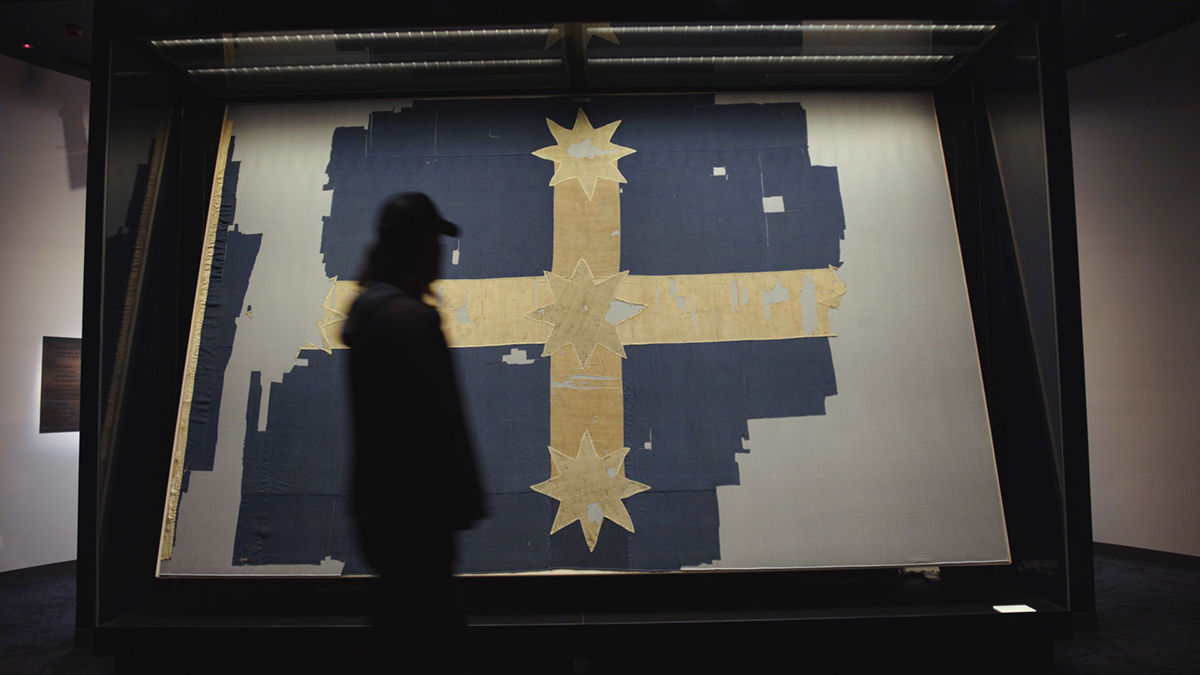
We Don’t Need A Map
TY Science fiction has a solid tradition of exploring the sentience of complex, self-organising systems. In literature, China Mieville probably does it best, although his books have not been made into films yet. It only occurs in fiction because the Western academic requirement of objectivity is a barrier to understanding our true relationship with the sentient universe. This academic view is placeless and seeks a mechanistic and broadly generalisable explanation of all phenomena, while the observer must pretend she or he does not exist while reporting it. The place where the observer stands, the standpoint within a dynamic landscape, must also be invisible. Indigenous knowledge is seen as subjective by the Western academy, but from our viewpoint the cosmos is communicating with us, so the things we see from our personal perspective grounded in our location are part of the story. So in the film you see that old lady singing the star story and including everything that happens in that moment in the song — clouds passing across the sky, birds flying, fish jumping…this is all part of that story of Skycamp and its communication with us in the moment.
LCH There are parts of the film that betrayed its television production origins: I found that the emotional tone and generic registers were not well sustained, and the digressions into rap, punk road trips and bush puppet reenactments were distracting. I think it would have been stronger and more sustained if it was a pure essay film, as the PR material described it. But I really loved the connection between talking heads in the bush, and Professor Ghassan Hage, who talks about how the Southern Cross is embedded in wider discourses of racism and fear that “have made refugees into exterminable objects” and of a “culture of exterminability” whereby we refer to inanimate, sinkable “boats” instead of people.
TY That discourse of exterminability is made possible by the false objectivity I mentioned previously, rendering the observer/speaker unaccountable and as invisible as the victims of their discourse. This is why the academy has historically de-emphasised subjective, supra-rational, diverse and place-based ways of thinking. I think the film does well in privileging these kinds of seemingly irrational and disjointed worldviews. It draws on a punk aesthetic to reflect this in the domain of contemporary film, and as you mentioned earlier it is an act of culture jamming. I don’t see this work as inconsistent; the film is characterised by constant and deliberate code-switching, not just between dialects and social registers but between genres as well. At times this is jarring but it is supposed to be. Warwick Thornton achieves this code-switching effect masterfully, and with a genius and humility that makes him my new favourite filmmaker. And he is never the invisible observer — we often see him in shot while he himself is filming another angle. This visibility makes him accountable for the knowledge he portrays and speaks to his cultural integrity.
LCH Yes — the way that Thornton casts himself as the filmmaker and central character, guiding us through the film, as well as the self-reflexive shots of him beside his cameraperson, is really important in showing that he’s a fallible human. He’s absolutely not playing the role of documentary’s traditional and supposedly objective, onscreen authority figure, like Michael Moore. How did you think the old stories told by elders related to the Western film techniques of talking heads and time-lapse photography? Do you think there’s such a thing as an Indigenous cinematic language?
TY Diversity is one of the few things that Indigenous cultures and languages have in common. As such, there isn’t really a single Indigenous anything, let alone a common cinematic language. Thornton incorporated the same kind of talking heads you see in docos like SBS’s series First Australians, but with the old people out bush in cultural contexts he did something quite new. He brought the viewer into the yarn, sitting alongside the knowledge keepers, and he wove the protocols of Indigenous knowledge transmission into these intimate episodes — something that is glaringly absent in the talking heads sequences filmed in the city. It forces the viewer constantly in and out of a sense of connectedness, so that we experience a sense of loss and separation over and over, instilling a cultural desire for authentic connection that endures long after the film is over.
LCH Another interviewee in the film, Dr Romaine Moreton, says, “I don’t think identity is contained in symbolism.” To me the film spoke to the limits and power of symbolism in personal, community and national identity. What did you think of her take on the relationship between identity and symbolism?
TY The transient cultures of industrial civilisation must constantly be shifting the meanings of symbols and memes to suit the shifting goals of ‘progress,’ which are dictated not by cultural needs but by the requirements of continual economic growth and resource extraction. Identity, meaning, movements and metaphors emerging organically from the demotic in human cultures are constantly co-opted and absorbed, then twisted to suit the needs of the powerful. Note for example the shift in the last 30 years in the meaning of symbols and metaphors pertaining to the idea of freedom. Freedom no longer means escape from tyranny, but the right of business interests to act without accountability for damage done to systems, land and communities. In Indigenous cultures, the symbols and stories that make up our identities endure in our Law, retaining their integrity of meaning over deep time. Our wealth is knowledge, not money and resources. Power for us is about accepting accountability for protecting sacred knowledge. Warwick Thornton honours his accountability to the knowledge that is shared with him in this film, and demands that his audience does the same.
–
We Don’t Need A Map, 2017, director, writer, cameraperson Warwick Thornton, writer, producer, cameraperson Brendan Fletcher, interviewees Adam Briggs, Dr Romaine Moreton, Prof Ghassan Hage, Baluka Maymuru, Bruce Pascoe, executive producer Marcus Bolton, in English, Warlpiri, Wardaman, Dhuwala and Dhuawaya, broadcaster NITV, 23 July
Top image credit: We Don’t Need a Map
With the end nigh, is it more important to take action to save the world or to create happiness for those around us?
Where theatre company Ten Tonne Sparrow’s first show, The Epic, was about creation myths, their new show forms a counter-response. The premise of Tamagotchi Reset and Other Doomsdays isn’t whether a catastrophe is imminent — that’s taken as a given — but the ethical ramifications about what to do while the world burns. Writers-cum-characters Scott Sandwich (sound artist and theatre-maker Tom Hogan’s stage name) and playwright Finn O’Branagáin take us on a tour-de-force through the doomsday myths of previous generations, from the fall of the Mayan empire to the nuclear bomb fears of the Cold War era. Eschewing a conventional narrative arc for an extended storytelling debate, Scott and Finn present their thoughts in a series of abruptly contrasting, thought-provoking and entertaining vignettes.
Introducing themselves as Scott and Finn respectively, Izzy McDonald and Paul Grabovac argue each position in a stream of energetic lectures, bringing a personal dimension to leaven the strongly researched and fact-rich material. It’s an inherently self-reflexive and self-referential production: the actors refer to director Joe Lui, introduce their own characters and establish an engaging ‘odd couple’ rapport that binds the production, with the gender swap emphasising the viewpoint and approach rather than the individual. Scott celebrates the achievements of humanity and the ongoing potential for creating happiness, while Finn succumbs to existential melancholy. They namecheck all manner of Judgement Days in a grab-bag mix: IBM engineers visiting a Tibetan mountaintop to assist a group of Lamas to hasten the end of the universe, the destruction of the Great Barrier Reef, and the death of teenaged Finn’s counterfeit Tamagotchi rat as Y2K hits during New Year’s Eve parties in Darwin. The unprepossessing yet demanding digital pet was hatched, fed, cleaned and played with, and Finn had reached a new month-long record of survival for this incarnation, when the keychain-sized electronic toy found itself unable to cope with the calendar demands of 2000. The recently relaunched Tamagotchi device is far more sophisticated, and Scott’s kind gift to Finn of the new and improved model informs designer Sara Chirichilli’s animated backdrop to the presentations, the cute pixel display responding to each apocalyptic scenario.

Paul Grabovac and Izzy McDonald, photo courtesy of EClaire Photography
Tales escalate at a slick pace as Scott and Finn broach the limits of their power as individuals to arrest environmental and societal collapse. McDonald shares Scott’s wonder at NASA’s Golden Record Voyager and its lonely arc through space; Grabovac rants Finn’s despair at the cycle of worry created though the ethical implications of every choice we make. Their mutual frustration with the other’s perspective grows. A detour to ancient Egypt brings a flurry of terror as benevolent Hathor turns into raging Sekhmet; we learn that what we love can destroy us and redemption is available in the form of beer as Finn and Scott follow the ancient rite to placate the enraged god of the Nile. Paul presents Finn’s deeply mournful elegy to the Bramble Cay melomys, a cute but isolated rodent from a small island on the Great Barrier Reef, using a fishbowl, ice, blowtorch and stuffed toy to evocatively demonstrate the first recorded mammalian extinction from anthropogenic climate change, contrasting with Scott’s playfulness in a roaring tribute to dinosaur existence.
Chirichilli’s brightly coloured, geometrically-styled set features versatile storage solutions from which illustrative props spring. Finn reflects on the escalating cycle of deforestation, competitive head carving and eventual starvation and slavery that led to the Polynesian island of Rapa Nui’s ecological and social collapse, whimsically expressing it all with a tray of Easter confectionery. Scott declaims the mythos of Cthulu, replete with old-timey dramatic foreboding. Scott’s beanies figure prominently and are emblematic of the playful costume design, incorporating Cthulu, alien Carl Sagan and triceratops among other elements of the apocalyptic case studies.
Tamagotchi Reset and Other Doomsdays evokes late 90s nostalgia, entertains through the didactic content and the contrasting of Finn’s earnest activism and Scott’s light-hearted compassion, using humour to offset the sudden and strident bursts of information. Scott and Finn declare their production a modern day version of an Easter Island monumental stone head, and despite the impending doom, we’re brought to a surprisingly upbeat ending that acknowledges the problems in this time and place, inspiring us to pursue our own hearts in the meantime.
–
The Blue Room Theatre & Ten Tonne Sparrow, Tamagotchi Reset and Other Doomsdays, director, dramaturg, lighting designer Joe Lui, writer, producer Finn O’Branagáin, writer Scott Sandwich, performers Izzy McDonald, Paul Grabovac, assistant director Michelle Aitken, designer Sara Chirichilli, sound designer, composer Tom Hogan, stage manager Sean Guastavino, The Blue Room Theatre, Perth, 20 June-8 July
Top image credit: Izzy McDonald plays Scott Sandwich in Tamagotchi Reset and Other Doomsdays, photo courtesy of EClaire Photography
Though it’s known for its mysterious imagery and disquieting phenomena — chevron stripes, inexplicable crying, clairvoyant logs, lessons of adolescence, slowly swishing leaves, red curtains and extra-dimensional rooms — Twin Peaks is a remorselessly sonic television series. Angelo Badalamenti’s compositions are the hooks the show hangs on and any attempt at merely covering these songs would be rather exasperating. Fortunately, Californian ‘art-rock’ band Xiu Xiu has no such desire. Their reinterpretation of the music of Twin Peaks is more like a meeting of two personalities; a metamorphosis where Xiu Xiu and the work of Badalamenti and Twin Peaks co-creator, David Lynch, relentlessly feed into each other.
Last year Xiu Xiu reinterpreted Badalamenti’s compositions with its album, Xiu Xiu Plays the Music of Twin Peaks, released as part of the David Lynch exhibition, Between Two Worlds, at Brisbane’s Gallery of Modern Art. Created in the 1990s, Twin Peaks remains a pivotal piece of Lynch’s oeuvre: an arthouse series that introduced us to both auteurist television and the murder of a small-town, blonde-haired and blue-eyed, homecoming queen. The show works by transforming a seemingly simple detective story — who killed Laura Palmer? — into scenarios that take on difficulties not often well addressed in popular television: domestic violence, abuse, incest, evil spirits and demonic possession. Likewise, Badalamenti evokes the melodrama of soap opera scores and the rhythms of jazz, only to summon something far more obtuse and perverse, the latency of which is intensified by Xiu Xiu’s reinterpretation. Xiu Xiu recently toured the album to Brisbane and Sydney, with two shows at The Substation in Melbourne, the second of which was supported by Canadian musician Sarah Davachi performing her own original work.
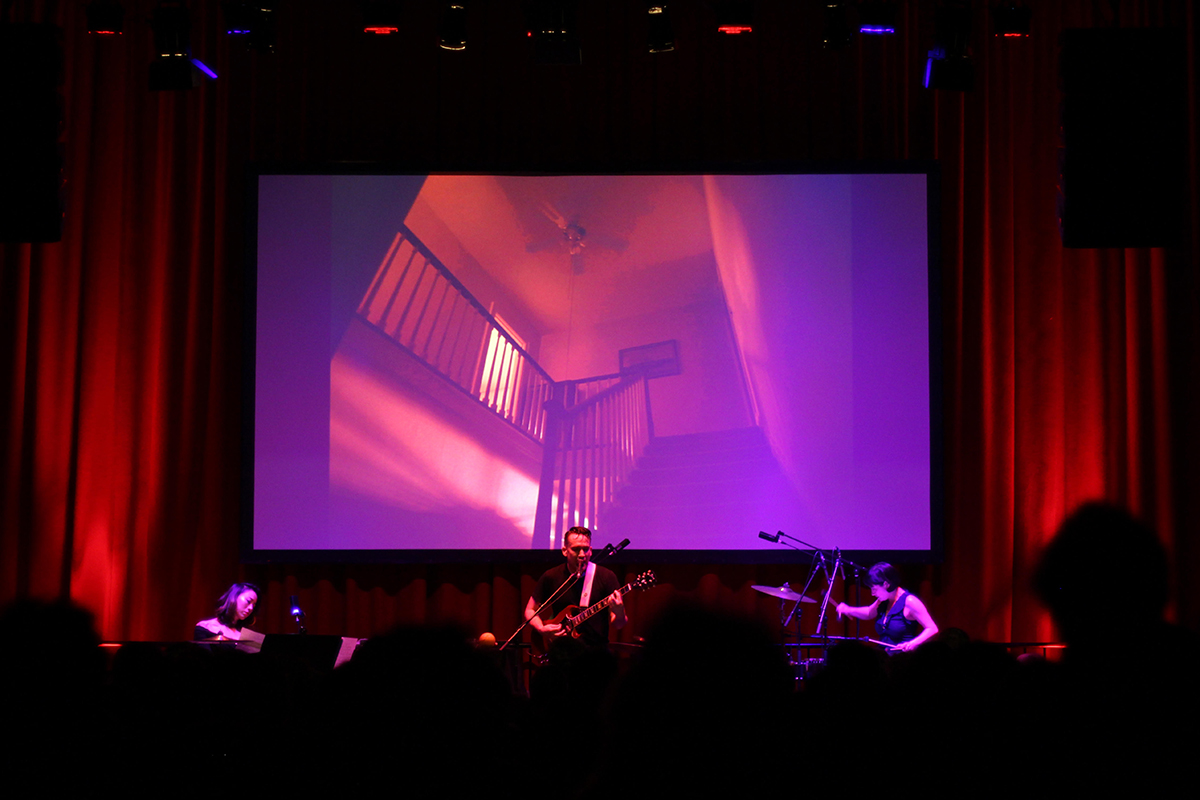
Xiu Xiu performs the songs of Twin Peaks, courtesy of The Substation
Sitting alone on stage, surrounded by her minimal equipment, Davachi has a purposefully understated presence. Primarily working with electronic music, Davachi’s performance builds on repetition, overtones and density. Her sustained and droning sounds both compete and interweave, so that no singular sound is allowed to stray from the pack. The darker layers protrude, while the more melodic lines lie buried: prominent enough to be heard, yet doing the trick of withholding melodic catharsis. Instead, Davachi’s music delivers a different joy; the peacefulness of the layered flat line.
Between Davachi’s and Xiu Xiu’s performances, I hear a few people comment upon the “positively Lynchian” qualities of The Substation as a venue. With its working class history, semi-industrial aesthetic and thick red curtains, it contains that conflation of mood and setting that is so pivotal to the Lynchian oeuvre. Xiu Xiu references the Lynchian penchant for dramatics by beginning the performance not with music but an essential and recurring visual from Twin Peaks on the stage’s screen. The camera incites us to look up the Palmer household staircase, briefly focusing on a moving ceiling fan, before resting on Laura Palmer’s open bedroom door. It’s an enigmatic moment that holds both Laura’s absence and presence, mixing banal domesticity with wordless terror. As this scene changes to a spinning fan and the Douglas Fir trees of Twin Peaks (visuals that repeat throughout the show), we’re continuously reminded not only of Laura, but the absence and presence of Lynch and Badalamenti.
While this initial scene holds our attention, Xiu Xiu’s Angela Seo walks on stage and hits ‘play’ on a drum machine. After setting off a repetitious single-hit pulse, she walks off, leaving the beat on loop. It’s a rather cool move and a few minutes later the entire band emerges. Seo sits behind her piano and plays Laura Palmer’s Theme, which contains those two incredibly authoritative opening chords, before further escalating the song’s quasi-soap opera moment, adding dissonant layers to heighten the already-grandiose climax. Shayna Dunkelman takes to the vibraphone (and it’s a pleasure just to watch her nimble grace), while Jamie Stewart initially sets himself behind a drum kit, his snare hits and cymbals eliciting a feeling of stress for the audience, a certain affectation that Stewart builds throughout the show. This dual preoccupation with homage and light theatrics persists throughout the night. While this could be viewed as overly self-conscious, to my mind it speaks to the generosity and emotional investment of the group’s performance.
From here the band sequentially performs the entire album Xiu Xiu Plays the Music of Twin Peaks. The obvious thing to say is that Xiu Xiu makes Badalamenti and Lynch’s compositions more dissonant, layered and darker. Yet this doesn’t nearly explain the relation between Badalamenti and Xiu Xiu, nor the weird and sudden expansions of sounds: the moments where Badalamenti’s melodies are enjoyed, only to be troubled by disparate intrusions. Xiu Xiu holds a clear reverence for pop sensibility (alongside a good sense of humour, found in songs like Audrey’s Theme and Dance of the Dream Man), aligned with a perpetually experimental impulse.
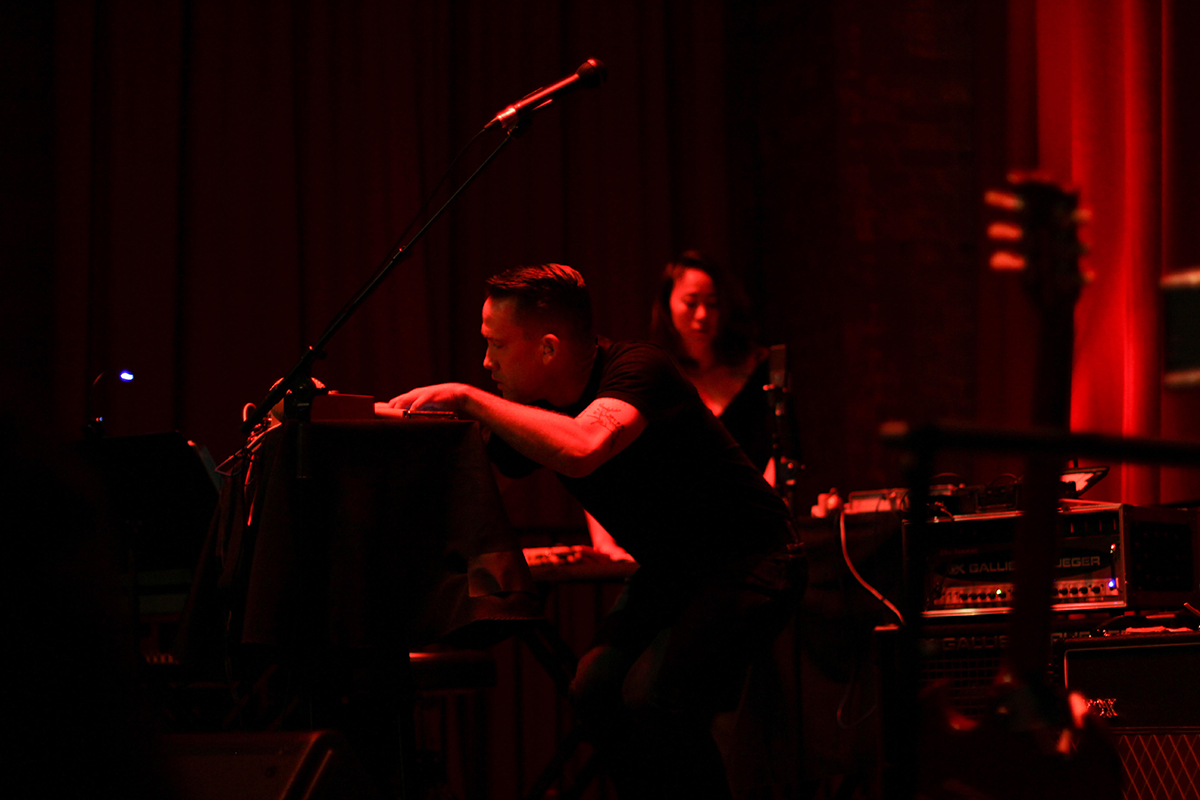
Xiu Xiu performs the songs of Twin Peaks, courtesy of The Substation
Because the band holds competing qualities — dissonance and melody, emotional upheaval alongside detachment — in such rounded and complex ways, watching Xiu Xiu play is like watching a puzzle reveal its logic. Sounds that I thought came from a synth turn out to be Stewart’s electric guitar; clusters of noise I thought were some kind of woodwind instrument stem from Stewart’s own mouth, while his neck tendons enlarge and his entire face goes red from sheer effort; a wash of notes and sustained chords that appear to be layers of piano and synth are, actually, just layers of piano and synth. With so many instruments needed to recreate the album experience (synths, piano, drums, guitar, vibraphone, harmonica), Stewart and Dunkelman spend the evening trading in equipment.
This hour-long accumulation of dramatics, pop sensibility and noise builds to the final song, Josie’s Past, where Dunkelman, in a dramatised teen-girl voice, reads the perverse confessions from Laura Palmer’s diary. After we indulge ourselves in the titillating thrill of secrets made public, Stewart’s voice breaks through in the style of a crooning and demonically possessed Leland Palmer. It slowly peters out to nothing, which seems fitting because it seems Lynchian (and this is both the trap and fun of the evening; seeing everything as somehow Lynchian).
As with any great show, it ends and you wish it didn’t. It’s the kind of performance that lingers for a few days, that makes you go home and play the record that very night, letting you indulge in that remarkable blend of something so unavoidably derivative and so utterly original.
–
Xiu Xiu Plays the Music of Twin Peaks, The Substation, Melbourne, 23 June
Tiarney Miekus is a Melbourne-based writer and musician who has been published by un Magazine, Art Guide, The Lifted Brow and Overland. Tiarney currently plays in post-punk group No Sister.
Top image credit: Xiu Xiu performs the songs of Twin Peaks, courtesy of The Substation
Given its scope, it’s tempting to call this exhibition A Working Model of the Universe, but curators, Dr Lizzie Muller and Holly Williams have humbly limited themselves to “the world.” Covering the top floor of the UNSW Gallery, this is a big exhibition made from more than 32 little things, including historical artefacts and prototypes, architectural maquettes and artistic renderings of the model manifested as painting, photography, sculpture and video. The curators are interested in how the model as microcosm can offer insights — practical, theoretical, spiritual — into the macrocosm. They have structured the exhibition around a number of non-exclusive classifications: the model as ideal, as proof, prediction, simulacrum; the model as an edifice of scale, an expression of a belief system, a step in the creative process or a tool of mastery. These provocations make for rich ruminations on works that concretise the speculative and speculate about the concrete.
Easing us into the exhibition are the kind of models we first expect — those of the built environment. Ten iterations of the Bondi Surf Club made for architects Durbach Block Jaggers show the building’s concept developed within a contemporary and commercial reality. Richard Braddish’s Sydney’s Tallest Buildings 1:1000 (Excluding Spires) 1788–2017, shows us the historical evolution of a city. The centrepiece is Bidjigal artist and elder Esme Timbery’s intricate shell-worked renditions of the iconic Sydney Opera House and Harbour Bridge: a model as a fusion of cultures and a quiet and delicate statement of reclamation.
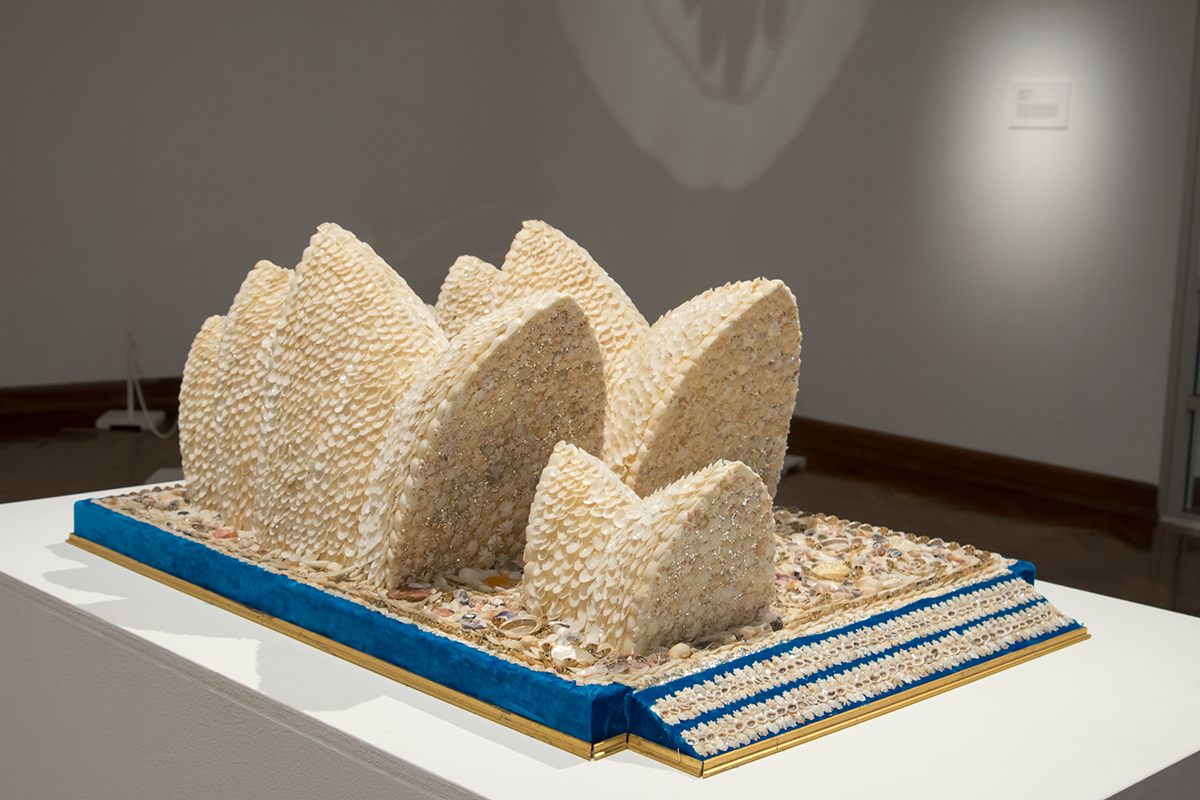
Esme Timbery’s Shellwork Sydney Opera House (2002), image copyright the artist, licensed by Viscopy
A darkened gallery to the right offers a cornucopia of wondrous and disturbing pieces, beginning with a kinetic work from Ian Burns titled Model Of A Model Of The Spread Of Ignorance. Small baby-monitors show still images of Donald Trump’s pursed lips and raging open mouth. The mechanical action of cogs and motors, adorned with cut-outs of Trump’s eyes, activates vision-switching to create a primitive, glitchy animation of this iconic ever-flapping orifice. The seemingly ad hoc, found materials smack of poverty — a poverty of thought, a poverty inflicted by ignorance — but also, in Burns’ artwork, a poverty that has bred ingenuity.
Jo Law also uses lo-fi kinetics and aesthetics to great effect. Across 10 tiny dioramas she maps out “some useful values” as presented by a high school chemistry textbook of scenes that incorporate what she calls “a set of values denoted by powers of 10.” With homemade electronics and cut-out images, the small boxes illustrate lightning moments of scientific discovery: light refraction, the invention of electricity, putting a man on the moon, the infinitesimal world of blood vessels. These tiny, ostensibly naive handcrafted pieces display a haunting fragility in their endeavour to explain the wonders of an enormous and baffling universe.
Upping the scale somewhat is Brook Andrew’s Tombs Of Thought: Water, reminiscent of a hot air balloon. An inflatable world is turned upside down and anchored by a glass and wooden structure, which at first appears to be a vitrine. Peering in, however, we see a series of nestled, ever-smaller boxes, whose interior angles are obscured by reflections from glass and mirrors. Though our line of sight is blocked, the structure’s Babushka-doll nature becomes apparent when viewed from the outside — the fine blond wood boxes of decreasing size offset by similarly diminishing legs of charred, lumpy timber. It is an obtuse and thought-provoking artefact, meticulous crafted.
In a more brightly-lit gallery to the left, at a scale of 1:1 is Peter Hennessey’s Overlooked (Streetview Capture Apparatus), a plywood replica of a Google Street View camera. A generally invisible technology, Google Street View currently captures almost every corner of our world (except the Faroe Islands where you have to resort to sheepview). Hennessey’s model of the technology’s hardware becomes a world in itself: on closer inspection, we see that it is infested with tiny human figures clambering up its towering structure. Whether they are building this tower Babel-like, or revelling in the great views its heights afford is unclear. What is apparent is that it’s much bigger than us and leaves us without a doubt that, as poet Richard Brautigan has written, we are “all watched over by machines of loving grace.”
David Eastwood’s Assemblage perhaps best exemplifies how the very meta nature of models makes them so fascinating. He has produced a series of paintings based on his own 1:15 model of the studio of the 16th century Italian painter Morandini. The scale of the model reduces the studio to the size of a still life, and the paintings that document the rearrangements of the space take on a curiously hyperreal (or is it a neo-real?) dimension. Assemblage is a replication of a replication of an historical reconstruction, and with each iteration the space takes on more of its own life, while remaining a representation of the thing it is, or was. It’s the hermeticism of this iterative loop that makes it strangely compelling. (The exhibition website also features an illuminating essay by Eastwood.)

Andrea Durbach’s Matchstick Boat, photo courtesy of Museum of Australian Democracy
Deftly placed among the speculative artistic models are a number of museum pieces that are no less artful. The Orrery, a 19th century mechanical model of the solar system, is particularly lovely, but its beauty is surpassed by the Avogadro Project Silicon Sphere, one of the roundest objects on Earth. This glistening ball of almost pure silicone was designed at the CSIRO as part of the international project to redefine the model of a kilogram as a specific number of silicone atoms (currently defined by a cylinder of platinum-iridium kept in Paris that is in a gradual state of decay). It is, without doubt, one of the most beautifully pure objects you can ever lay eyes on. So round and reflective is it that you feel your eyes constantly sliding off it. It is a model of an ideal, an object that defies entropy and seeks a level of perfection that is antithetical to the messy workings of the world — and it is utterly beguiling because of this.
But for me the most affecting model is the Matchstick Boat by The Upington 25 on loan from lawyer and Human Rights campaigner Andrea Durbach. The model boat was created by a group of men and women falsely accused of murdering a policeman in 1988, during Apartheid in South Africa. Painstakingly pieced together from matches, the prisoners presented it to Durbach, their defence lawyer, during the trial. The Matchstick Boat is a deeply moving example of the power of hope that can manifest in a model.
This sense of hope underlies nearly all the works in A Working Model of the World. The model is generally built before the real thing — be it object, building or world — and thus allows for so many possibilities. At the point of making a model we are still gods, or alternately still children tinkering with our doll’s house. Either way the possibilities gradually get shut down as the pressures of the real world take over, as the true scale of the enterprise exerts its power. But it is this sense of inspiration and aspiration, in the face of the harsh practicalities of actualisation, which make A Working Model of the World a thoroughly thought-provoking and quite magical exhibition.
–
A Working Model of the World, curators Dr Lizzie Muller, Holly Williams, UNSW Galleries, Sydney, 5 May-22 July
Top image credit: Silicon sphere from the Avogadro Project, 1991-94, image courtesy CSIRO
A torch light cuts through the darkness. The face of a child grins from the shadows, cocooned in a tunnel of rubbish. “We’ll make a space here to sleep!” he declares, rolling happily in layers of plastic. This evocative opening of Wang Jiuliang’s Plastic China expresses the film’s implicit message in imagistic form: the more affluent we become, the more we are carving out homes built on rubbish. But for all its subtle commentary on a global cycle of production, consumption and waste, Wang’s new documentary is anything but hectoring social comment. His human subjects exude a warmth and aspirational desire that throws the social, economic and environmental complexities of our world into sharp relief.
Wang initially made a name for himself as a documentarian with Beijing Besieged by Waste (2011) (trailer below), an alarming exposé of the numerous unregulated rubbish dumps laying siege to China’s capital as its new wealthy and middle classes embrace a throwaway lifestyle. Plastic China was six years in the making, as Wang furthered his investigation of global waste disposal practices in the wake of his first film’s success. Researching in the US, he was shocked to discover massive shipments of American refuse bound for his homeland. In China, the rubbish is recycled, mostly in tiny plants surviving on wafer-thin profit margins made possible by lax safety and environmental standards. Following the rubbish trail home led Wang to the recycling plant we see in Plastic China, located near Qingdao on China’s north coast.
Although the film is largely observational in style, the filmmaker is an embodied presence, whom the onscreen subjects often address to comment on their lives and situations. They are participants in the telling of this story, rather than the passively observed objects of more fly-on-the-wall approaches to documentary.
The plant we see is run by Kun, a former farmer in his late 20s with a five-year-old son. He explains to camera that although recycling plastic produces minuscule profits, his income is still higher and more consistent than when he worked the land. Kun and his wife labour hard, feeding large piles of plastic into an industrial shredder by hand. The strips are then melted and shaped into tiny reusable pellets. Rather than recycling, this is actually down-cycling, converting cheap plastic goods into lower grade plastics that are then used to produce yet more disposable items. The down cycling process creates a putrid liquid that fouls local waterways and fumes that pollute the air. Kun endures all this so that he can raise the funds to educate his child.
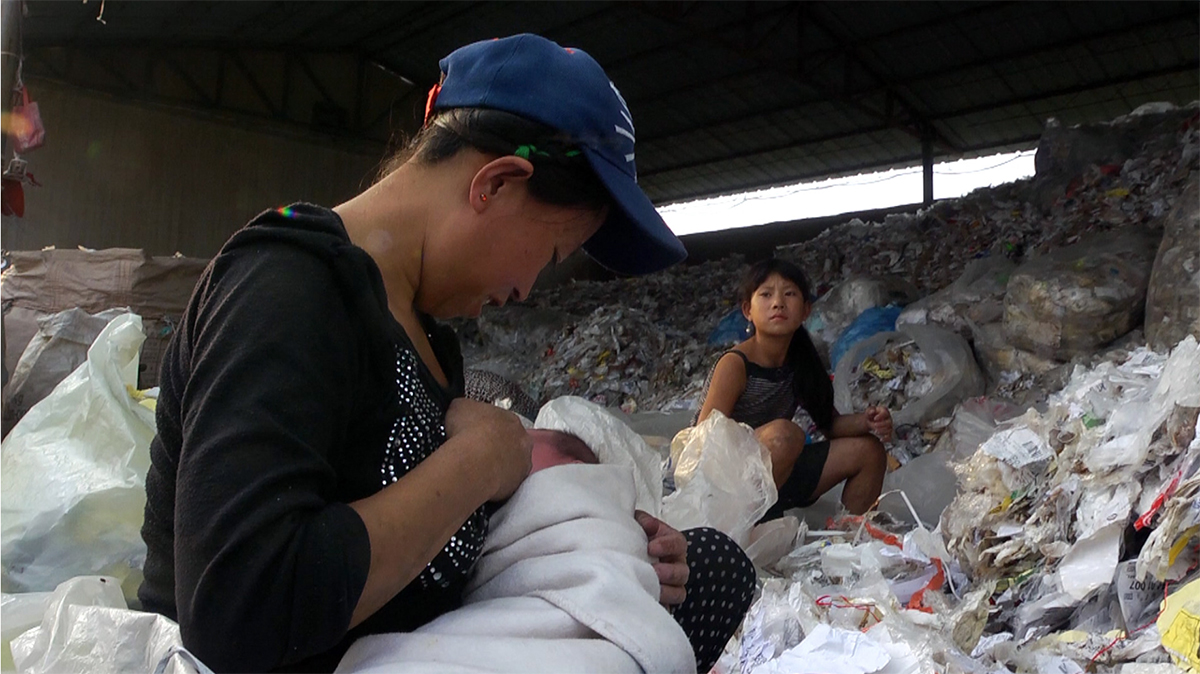
Plastic China
At the other end of the aspirational scale is Peng, a father of five who labours in Kun’s plant for the equivalent of about six dollars a day. The predicament of his 11-year-old daughter, Yi Jie, provides the film’s emotional nexus, her desire for schooling and the chance to transcend her grim surrounds a counterpoint to her father’s wayward alcoholism. Yi Jie is well aware of what her family lacks as she eyes the glossy advertisements from magazines pulled from the imported waste. She and her younger brothers build a “computer” from old boxes, and she gleans a few words of English from a deck of flash-cards rescued from the rubbish. Her family’s poverty heartbreakingly precludes Yi from grasping the opportunities she can see all around her.
Although the situation Wang captures is grim, Plastic China resists the temptation to sermonise or provide smug ‘what we can do to help’ solutions. The film also resists easy finger-pointing regarding the pollution pumped out by Kun’s recycling operation, instead adopting a more emotionally detached tone that shows rather than judges. Yi Jie and her brothers live in atrocious conditions, and Kun’s family is barely one step up the social ladder. They are surrounded by images of the good life on television and, more poignantly, in the rubbish they recycle. They have every right to aspire to improve their situation, and Kun’s family at least appears to be on the way to something better, even as Yi’s family appears mired in a poverty trap. Towards the end of the film, Kun takes his family on a visit to Beijing, where they gaze in wonder at the expanse of Tiananmen Square and the towers stretching to the horizon. “You have to get an education,” Kun urges his son, “so that in the future you can bring your dad to live in Beijing. This is where the rich people live.” Given Kun’s drive and intelligence, he and his son might just pull off this dream.
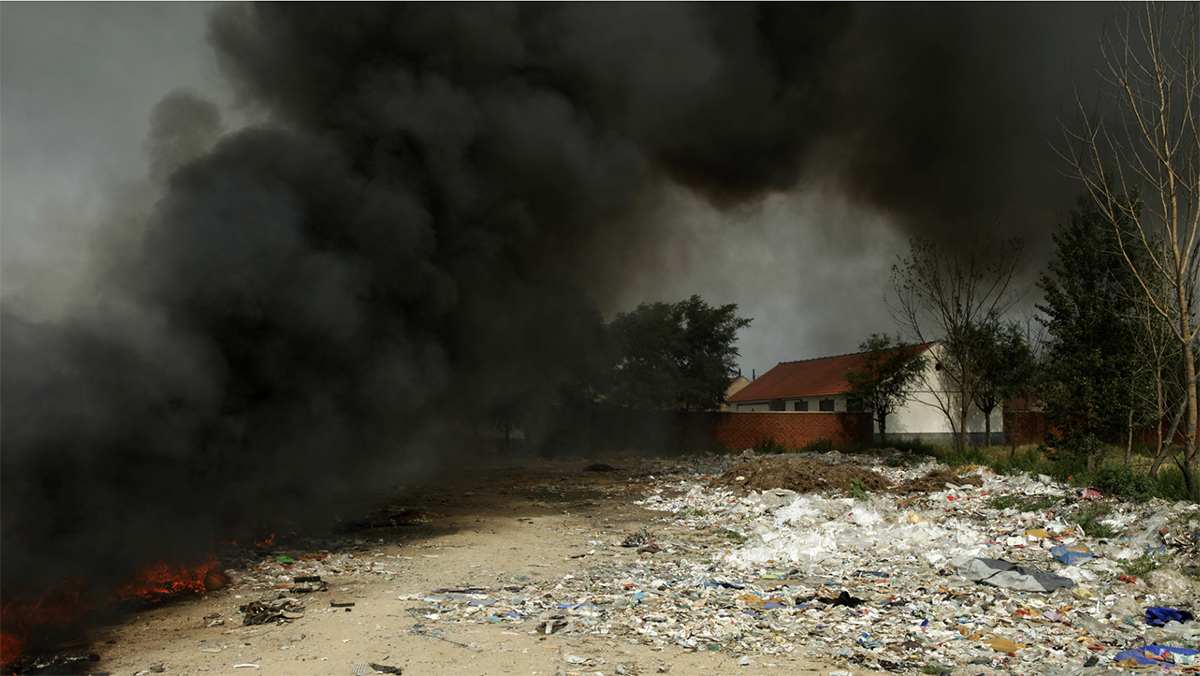
Plastic China
Yet the implicit question in all of this is where does the aspirational cycle end? The highlife enjoyed by the West and China’s rich and middle classes is supported by the cheap labour of others, even as those labouring scramble to climb over each other to reach the top of the pile. Meanwhile, we all consume more and more, and produce ever more rubbish, in an ever intensifying cycle of environmental degradation. Why do we all aspire to throw away so much? Are any of us willing to lower our material conditions so that those on the bottom can have something comparable without completely destroying the planet? As Plastic China concludes, another load of imported rubbish is unloaded as Yi Jie and her siblings play among the scraps.
Wang’s sophisticated film is one of a number of highly successful works to emerge in recent years produced by CNEX, a non-profit group founded 10 years ago to foster independent documentaries across Taiwan, Hong Kong and mainland China. CNEX has helped filmmakers like Wang tailor their work for a broader global audience. While encouraging the prolonged, empathetic engagement with subjects that has long characterised Chinese documentary, CNEX has urged directors to adopt tighter editing, shorter running times and touches like intertitles to make works more accessible to international viewers.
The result of CNEX’s efforts has been a string of recent titles acclaimed at film festivals around the globe, including A Young Patriot (Du Haibin, 2015), The Road (Zhang Zanbo, 2015) and The Chinese Mayor (Zhou Hao, 2014). Plastic China is one of the first Chinese works to cast its gaze beyond China’s shores and consider the complex relationship between Western lifestyles, Chinese aspirations and lingering, entrenched poverty inside the People’s Republic. If China is plastic, Wang’s film shows us, it’s because we became plastic first. If China is polluting, it’s because she has followed the West’s lead. This is a system that implicates all of us, linking the recycling bins outside our homes to the lives of small children in China. Wang may provide no solutions, but he asks questions addressed to us all.
–
Plastic China, director Wang Jiuliang, producer Ruby Chen, CNEX, People’s Republic of China, 2016, Human Rights Arts and Film Festival, ACMI, Melbourne, 4–18 May
Top image credit: Plastic China
Lights dim, the enclosed stage area fills with smoke, torchlight cuts through the gloom in truncated moving beams, with two shadowy figures calling to each other. A sudden ball of light, shot through with colours, explodes in the smoke behind them, lingering a little longer than lightning and leaving the characters and audience dazed in its wake.
For her new work, Western Australian writer-director Zoe Pepper offers an experimental and eclectic work of constantly criss-crossing plots and characters, played by just two actors. Co-produced by Side Pony Productions and The Last Great Hunt, The Irresistible’s interwoven narratives are realised with tightly coordinated sound design, innovative pitch-manipulation of actors’ voices and a simple yet startling set involving transparent layers within layers that enclose the actors within a strange, self-contained onstage world.
Events unfold in The Irresistible in a way that defies description. We open in the cockpit of an aircraft. Two co-pilots, played by Tim Watts and Adriane Daff, exchange workplace banter; everything runs smoothly until one pilot is gripped by a mysterious force, sending the plane hurtling to a fatal crash landing. This enigmatic energy may also feed new character Bridget’s obsession, confining her to a world of mental illness. Though she insists that she and her sister April were taken somewhere in a childhood memory, April staunchly denies it.
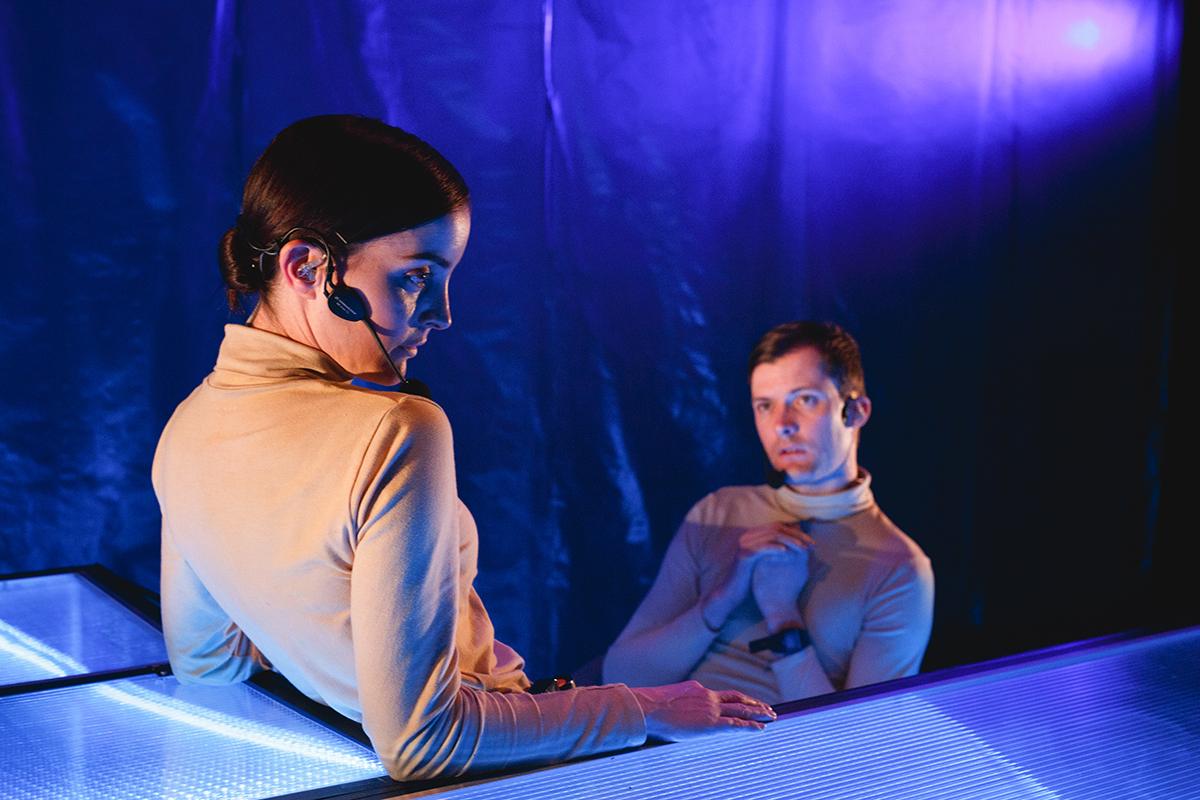
Adriane Daff and Tim Watts in Zoe Pepper’s The Irresistible, photo by Dan Grant
Watts and Daff play the entire array of characters in functional, matching costumes of industrial-styled coveralls: a bickering odd couple, council worker Eric and medical doctor April; Niamh and her regular peep show client Christian; April and Bridget and their young niece Cassie, an evil child whose imaginary friend Abby makes an implied appearance. Watts and Daff both play male and female roles, reversing gendered expectations and sublimating physical appearance. As their cast of characters swiftly come and go, my mind tries to find a common thread, but I’m mainly left with admiration for the versatility and ingenuity of the two actors who manage to create such a crowded stage with a total absence of costume changes or props. Split-second timing allows Daff and Watts to switch between characters with vocal pitch changes captured through their headset microphones. Far from a mere gimmick, these tight, precisely-timed changes enhance the performers’ body language, posture and changes in stance — these characters are believable and compelling to watch, with the scenes and roles often changing between breaths.
While Pepper’s script abruptly shifts between all these human interactions, a recurring motif of torchlight beams cutting through the gloom hints at a greater irresistible force driving them all — and moving us toward an eerie, inconclusive ending. Whether this mysterious light is a deeper shared, connecting imperative or simply a sideshow in the night sky is left to the audience to contemplate.
The show alludes to themes of dominance, gender roles, entitlement, family responsibilities and social expectations, all queried as forms of unconscious bias in our everyday lives. As constructs, these forms of bias clearly necessitated deep research on Pepper’s part, yet the work still functions as an absorbing piece of entertainment, with the grander narratives hinted at in the turn of a shoulder, a trick of the mouth and a slurring of vowels.
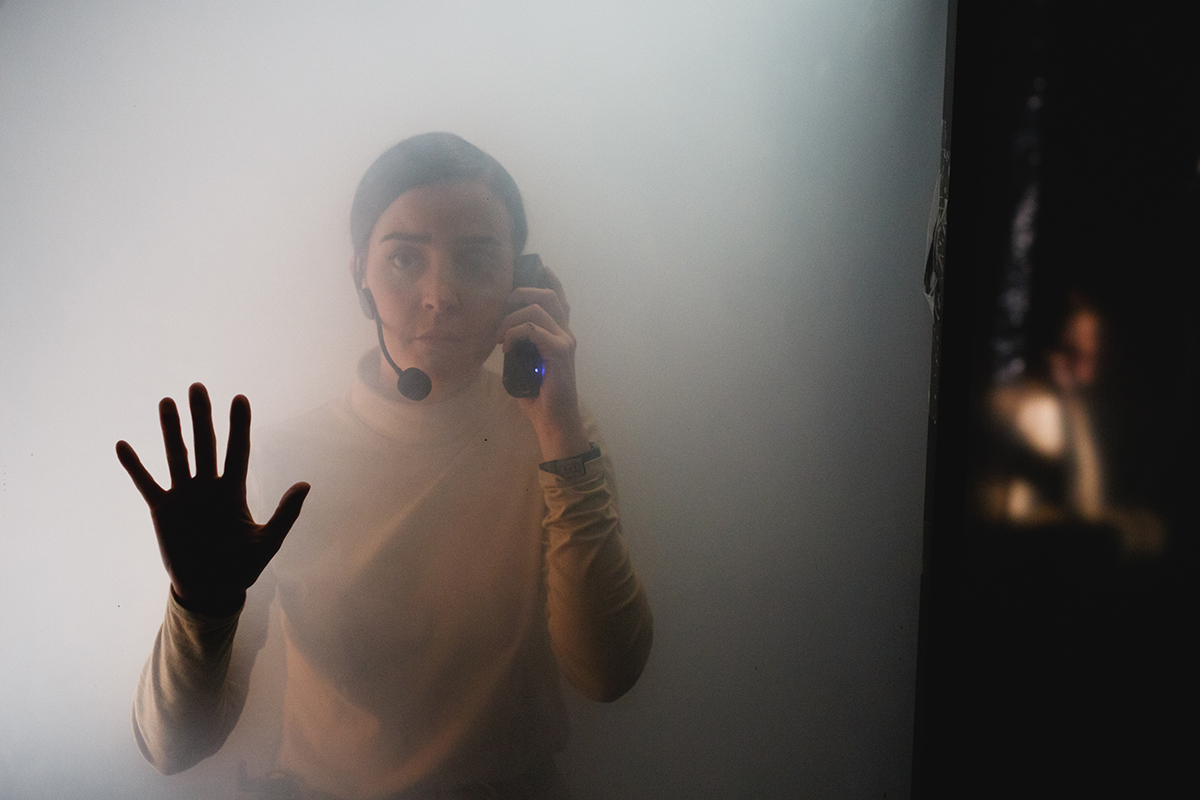
Adriane Daff and Tim Watts in Zoe Pepper’s The Irresistible, photo by Dan Grant
The production arrives in a wider context of experimental performance among Perth theatremakers. The Last Great Hunt consistently produces engaging and interesting theatre, pushing theatrical boundaries by integrating performance techniques across genres and reconsidering the narrative imperative. The Last Great Hunt’s recent work, The Advisors, was a peculiar exploration of cultural norms expressed through spoken word and physical theatre, while Pepper’s recent directorial project The Confidence Man also played with character-driven narrative and inventive uses of audio technology. Perth theatremakers are delivering not only intriguing new works but also providing a new take on established pieces: this year, The Last Great Hunt member Jeffrey Jay Fowler’s direction of The Eisteddfod by Lally Katz impressed audiences and critics with the way it embraced ambiguity and entrusted the audience with their own creative interpretation.
Jonathon Oxlade’s innovative design for The Irresistible literally contains the action in a sealed transparent set, in which layers of clear plastic sheeting form transparent boxes. Richard Vabre’s exacting lighting design is closely integrated: the set’s layers within layers fill with smoke effects to create vacuums of cloud, steam and fog in a way, conjuring the ambiguity of human memory and motivation. Phil Downing and Ash Gibson Greig produce a rich and complex soundscape, in which the shifts in character development are deeply embedded. Daff and Watts deserve recognition not just as actors but as collaborators interpreting Pepper’s intelligent and challenging script. The resulting production is disconcerting yet captivating; it fascinates, perplexes and rewards close attention.
–
Side Pony Productions & The Last Great Hunt, The Irresistible, director, writer Zoe Pepper, writers, performers Adriane Daff, Tim Watts, set and costume designer Jonathon Oxlade, composer Ash Gibson Greig, sound design Phil Downing, lighting design Richard Vabre, producer Gemma Pepper, production manager Ben Kontoolas, stage manager Hannah Portwine, gizmo specialist Anthony Watts, PICA Performance Space, Perth, 14-24 June
Top image credit: Adriane Daff and Tim Watts in Zoe Pepper’s The Irresistible, photo by Dan Grant
Objectillogica: a modern wunderkammer, curated by Megan Schlipalius, is an exhibition based on the cabinet of curiosity fetish of the past. This exhibition is thematically anchored in Eurocentric history but looks to the more recent past of Australia’s colonisation and the curiosities of the Holmes à Court collection, presented at Vasse Felix winery, a striking piece of architecture in the rambling countryside of Margaret River. Paintings and objects are clustered across the walls, sculptures adorn the floor and several glass-fronted, custom-built cabinets house a diversity of treasures, from carved animals to woven hair and feathers and bronze sculptures.
The Wunderkammer of the 16th to the 18th centuries was a prodigious source of inspiration for the noble classes. It was a way of knowing the world, an expression of power, as though the collections of taxidermied animals, fossils, relics, shells, artworks and other artefacts could offer a portal into far flung exotic places. It was also an early expression of colonial ideology. As writer Ian McLean observed in 2010, “The taxonomies displayed in its rooms and cabinets were imagined as micro-scenes of the world. They are amongst the first fruits of a new world founded on European colonial expansion and mercantile acumen of global reach, and signal a burgeoning desire to not just re-order the cosmos but to know, own and control it.”
As such, the Wunderkammer was also an early expression of Enlightenment thinking. It projected forwards, as much as it looked back to the past through the collection of ancient objects. Today there are contradictions inherent within the idea of the Wunderkammer, for while it was once taken so seriously, as a method of categorising, understanding and containing otherness, it is presently viewed as an odd and whimsical pastime for those who had too much time on their hands. In another guise it has also infiltrated contemporary art and Wunderkammering, a term dubbed by McLean, is a curatorial and artistic strategy of mixing, matching and clashing together objects from different times. It fits well within a postmodern and post-colonial logic and over the past decade there has been something of a revival of Wunderkammer exhibitions and their critical evaluation within the Australian context, including Curious Colony: a Twenty First Century Wunderkammer at Newcastle Regional Gallery in 2010 and Wunderkammer: The strange and the curious, at UQ Art Museum in 2015.
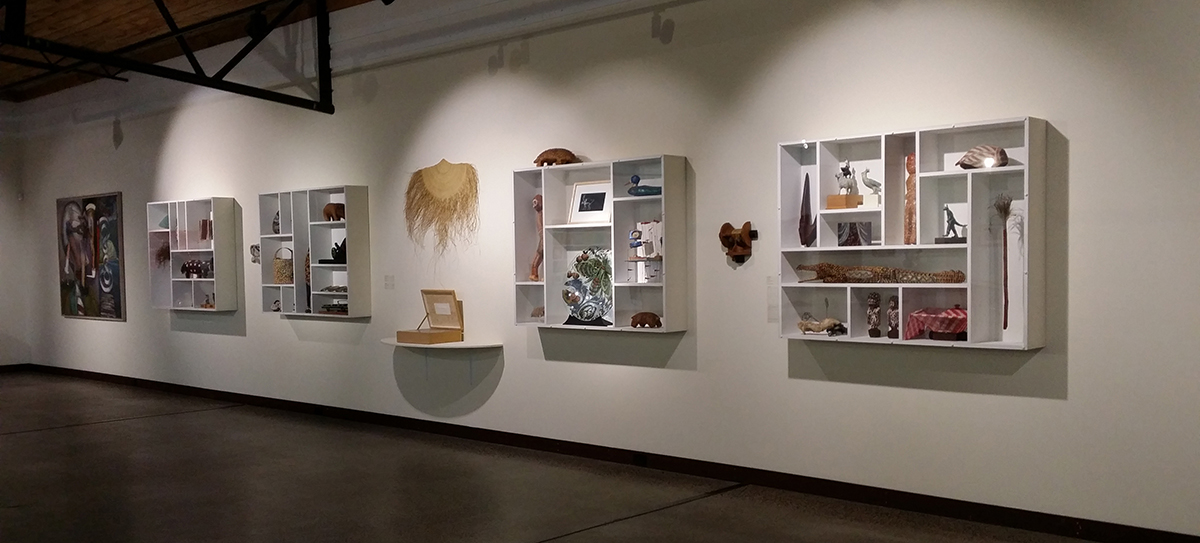
Installation shot of Objectillogica, photo by Megan Schlipalius
Sourced entirely from the Holmes à Court private collection, Objectillogica subtly unfolds and brings together a selection of Indigenous, non-indigenous, colonial and contemporary works dating from 300BC to 2014. Despite the Wunderkammer originally being a kind of proto-museum of contemporary museums, Schlipalius told me by email that “the arrangement of works was mainly inspired by the notion of an anti-museum. This approach was initially inspired by MONA’s Theatre of the World — although at a much more modest scale! I attempted to put disparate objects next to each other while creating a visual balance throughout the cabinets.” The MONA connection is significant, as David Walsh’s institution is also founded on antagonism to the usual museological conventions of display and curation.
Likewise, Objectillogica is an anti-museum in that it eschews the traditional taxonomic systems of museums and early curiosity cabinets. This exhibition is also in tension with the minimalist hangs of many contemporary art displays, instead pushing to fill all available space and, rather than being arranged according to similitude or taxonomic rigidity, there are thematic currents running through the show that make it compelling as well as cohesive. What is taken from MONA’s Theatre of the World is the Wunderkammering approach of mixing ancient, modern and contemporary, artefact and art and, rather than drawing from all reaches of the globe, it is largely located in the Australian and primarily Western Australian contexts.
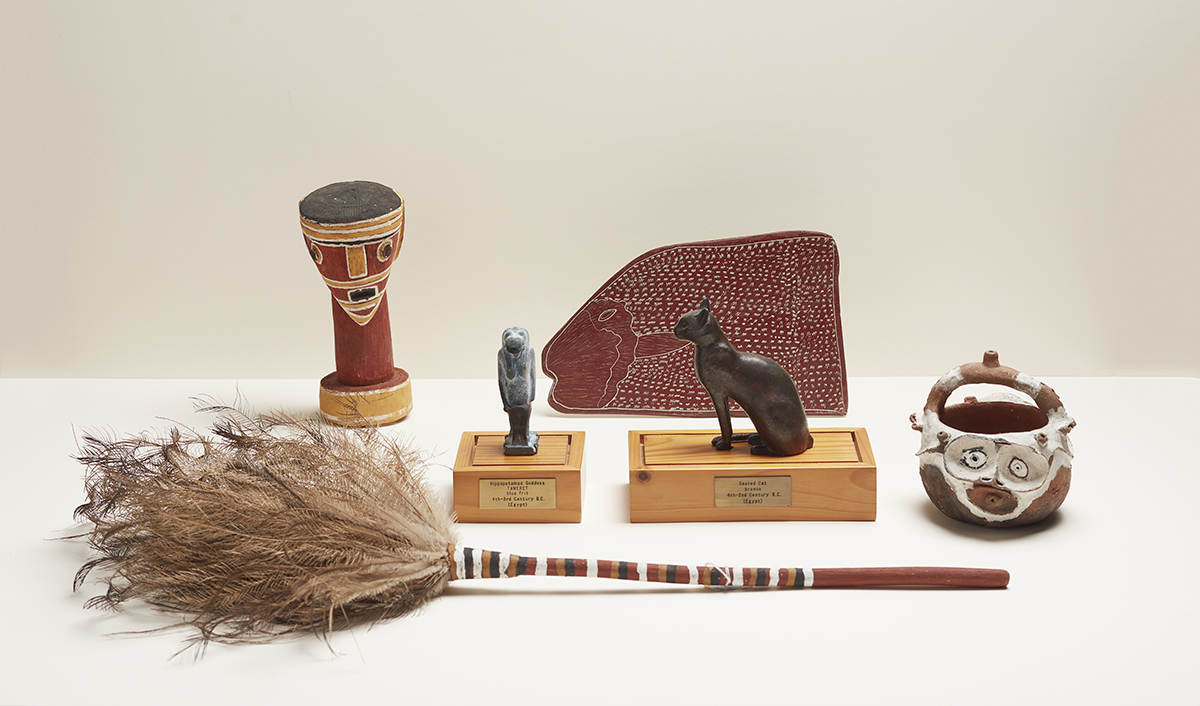
Unknown artists from the Kimberley region, Egypt and Papua New Guinea, photo by Robert Frith, Acorn Photography
The show considers a specifically Australian ‘wonder,’ where it is apparent that the collecting process, by Holmes à Court, has been driven by a keen eye for the historically significant, culturally relevant and occasionally obscure. There are exquisite works of art on display here and the obscure has been brought to the forefront in keeping with the traditional Wunderkammer, as a way to reveal and revel in the curious. At the entrance is a linocut by Rew Hanks titled The Hunter and the Collector. It features botanist Joseph Banks surrounded by a plethora of objects that relate specifically to Banks, such as Banksia flowers, May Gibbs’ wicked Banksia Men and the prickly pear weed introduced by Banks. At his feet is an image of the jar containing the head of Pemulwuy, the Indigenous warrior resistant to colonisation whose head was reportedly sent to Banks in England. This image critiques colonial attitudes and makes evident the damage wreaked on ‘new worlds.’
This is where the relevance lies in presenting a Modern Australian Wunderkammer. Like a transhistorical lesson, it offers ways to rethink events of the past and reconsider our place in the world; there is revelatory strength in mixing old and new. This makes it serious business, with biting political commentary, but there are also currents of humour running through this interpretation. There is the obligatory crocodile, in this case Francella Tungaltalum’s Yirrikapai (The Saltwater Crocodile), in a nod to museological tradition. There is a toolkit made entirely of extruded plastic by the artist Eamon O’Toole. The Wunderkammer presented here is still a way of knowing the world, of teasing out the idiosyncrasies of the local and national context with all its inherent layers of meaning and playfulness.
–
Objectillogica – a modern wunderkammer, curator Megan Schlipalius, Holmes à Court Gallery at Vasse Felix, Cowaramup, WA, 21 May-1 Oct
Top image credit: Danie Mellor, Hunter Gatherer, 2008, mixed media with shopping trolley, image courtesy the artist
Reason for Travelling
I first went to Japan in 1980 and I continue to go ever since. The ancient culture lives in the present. Japan throws all our assumptions upside down and makes us review our own culture. It has the best of two worlds being grounded in a strong heritage yet a world leader in innovative technologies. There is widespread belief in excellence and quality in all things and it shows.
I was led to Japan by my love of cinema, having studied Japanese classic cinema in London in 1971. The depictions of Japan by filmmakers like Ozu, Mizoguchi and Kurosawa entranced me, and have stayed with me through the years in my work as a photographer, curator and Creative Producer of Arthere, as well as through my long association with Stills Gallery in Sydney.
It is possible to go to Japan from Australia for short trips and get a complete break. There is minimal jetlag — two hours difference — and if you have time to go for longer you can explore the country from top to bottom.
Why Kyoto?
When I first went to Japan I headed for Tokyo, which has the largest population in the world and where day and night are like two different realities. For the young, your energy meets this city.
However, I recommend going to Kyoto if you have not been to Japan before. It is the most beautiful city in the world. Originally the capital (where the Emperor lived until 1868), it is still regarded as the elite place to live in Japan and has become the country’s cultural and heritage centre. The pleasure of Kyoto is walking the streets day or night and discovering stunning traditional architecture such as bamboo houses. Serendipity is a major factor in Kyoto where delightful things continually present themselves on the way to places in the tourist guidebook.
Walking at dusk in the Gion area you may sight geisha and maiko. You must be in the right place at the right time. Even the locals get excited at seeing geisha. Walk the alleyway leading off Shijo Street (closest to the Kamo River on its western side) and try any of the restaurants that sit alongside the river.
For contemporary arts and culture follow the stylish young people into music and bookshops. They are finely tuned to Western culture. For shopping (be warned, it’s everywhere!) visit Teramachi covered walkways (there are two parallel) and then go to Gokkomachi dori (street) one parallel to the west and see artistic designer and traditional shops and head to Café Independants for a drink and a meal. It’s a young person’s hangout, and there are brochures for art events in Kyoto on the wall.
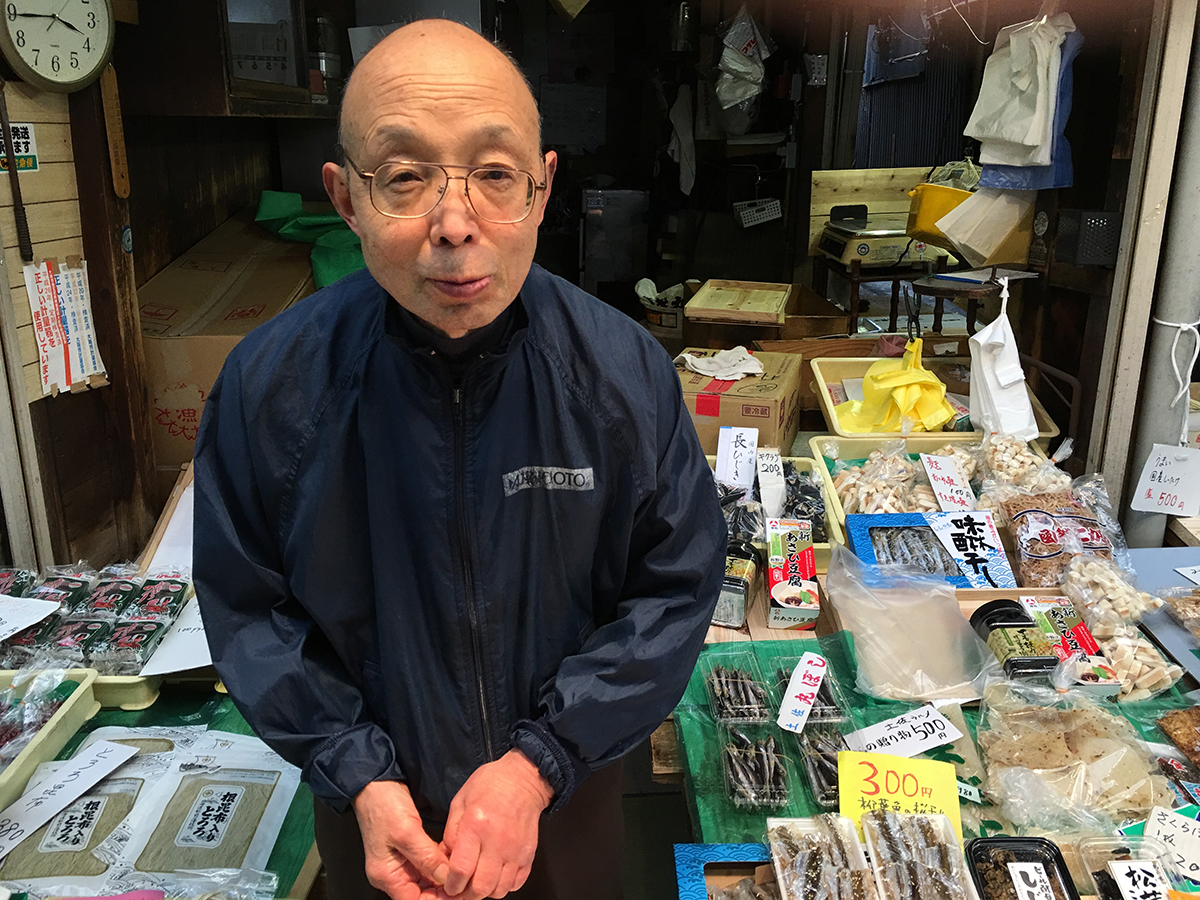
Vendor selling fish, photo Sandy Edwards
For refreshment…
Food in Japan is wonderful as long as you are adventurous. The diet is hugely different to our own so do not expect rice bubbles for breakfast; rather imagine a riceball with umeboshi in the middle of it (onigiri = riceball, umeboshi = sour plum, ume = plum).
The Japanese are both traditional and incredibly refined gourmets. They choose the best of everything around the world. They love French bakeries for example and do their best to imitate them. Kyoto specialises in a traditional cuisine called kaiseki, a meal of many dishes equivalent to Western haute cuisine. A reasonably priced kaiseki restaurant in Kyoto is Giro Giro Hitoshina, which sits near the Kamo River (Kamogawa) south of Shijo Street in central Kyoto, and should be booked in advance as far as possible.
Head to the Nishiki markets in central Kyoto. It is open daily and a great source of free snacks. It will be crowded but worth it.
The other treat is the food section of any department store. These are mindblowing in their novelty and a great way to get to know the Japanese cuisine. Seek out mocha (rice cakes).
Sake is God’s (Buddhist) gift to humans. It is made of rice and pure water (mizu) with a yeast binder. The sake culture is as refined as wine culture in the west. Explore and sample in department stores.
If you have a food allergy (I am gluten intolerant) you may have problems. Carry a card in Japanese explaining your requirements.
For temples (dera) and shrines (jinja)…
There are two primary religions in Japan: Buddhism (of which Zen Buddhism is part) and Shinto. Temples are Buddhist with a distinctly gracious architecture. Shrines are Shinto and are recognisable by their orange/red toriis (Japanese gates).
The most famous Shinto shrine in the outskirts of Kyoto is Fushimi Inari Jinja. This magnificent heritage site features thousands of toriis closely lined on walkways up the hillside. Each torii is a memorial to a family member who has died. There are teahouses to stop at and resting places with beautiful views of Kyoto.
The Higashiyama hills on the east side of Kyoto are full of temples, teahouses and walks. The Philosopher’s Path extends for two kilometres from Ginkakuji Temple in the north to Nanzenji Temple in the south. A little further south is Kyomizudera. This is usually my first point of call when I arrive in Kyoto. It is an independent Buddhist temple that provides unequalled views of Kyoto from its large wooden platform. The walkways to Kyomizudera are full of craft and food shops creating a delightful experience. The only downside is that this important temple is a major attraction to tourists so crowds can be daunting at times.
Other popular shrines and temples are Kinkakuji and Ginkakuji (the gold and silver pavilions).

photo Sandy Edwards
For culture…
The Kyoto Visitors Guide lists all exhibitions and art events in Kyoto. There is the Kyoto Art Centre and The National Museum of Modern Art, but my personal recommendation is the Kahitsukan Kyoto Museum of Contemporary Art, a privately owned museum on the west end of Shijo Street. It features photography and photography books and pottery. On the top floor a maple tree grows through a circular hole in the roof, turning orange and red in autumn. If you like pottery I recommend the Raku Museum.
Kyoto is distinguished by many Japanese wonders such as zen gardens, the classic one being Ryoanji, and places of historic significance such as the Katsura Imperial Villa which you must apply to visit in advance of your trip.
For day trips from Kyoto…
If you want to see contemporary art museums and galleries go to Osaka for the day and check out The National Museum of Art Osaka, the Habeno Harukas Art Museum located in Japan’s tallest building (great views of Osaka) and the Osaka Culturarium Tempozam designed by Tadao Ando.
The Miho Museum, the original model for Tasmania’s Museum of Old and New Art, is set within total greenery in a hilly area a few hours by train and bus from Kyoto.
For a traditional experience, go to Arashiyama for the bamboo forests. They are beautiful.
To do justice to the art islands (Naoshima, Teshima and Inujima) you need a minimum of three days including travel from Osaka or Kyoto. A visit should not be rushed. There are multiple art locations on each island requiring transport by bus and ferries. There are only a few of these island-to-island each day. The locations are stunning. The art is state of the art contemporary and these islands created by Benesse Holdings Inc and Fukutake Foundation have put Japan on the international art map in much the same way as MONA in Tasmania has. My special recommendations are the Hiroshi Sugimoto installation Go’o Shrine part of the Art House Project, the Teshima Art Museum designed by Tokyo architect Ryue Nishizawa and artist Rei Naito and Teshima Yokoo House, a converted house now museum featuring the psychedelic work of artist and designer Tadanori Yokoo. A bonus if going to Naoshima and Teshima from Takamatsu port in Shikoku (rather than from Uno on Honshu) is a visit to the Isamu Noguchi Museum in Takamatsu.
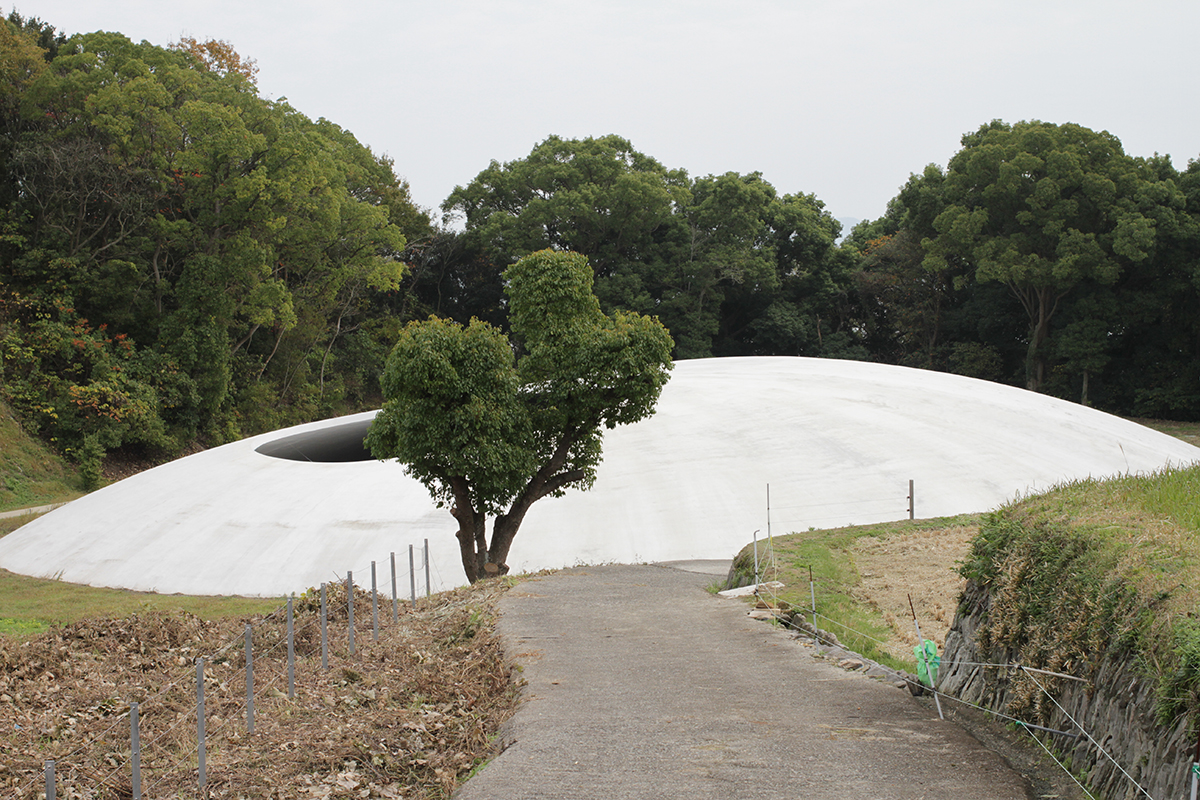
Teshima Art Museum, photo Sandy Edwards
For the greatest relaxation…
Do not miss the bathhouse experience. Open daily from 3pm to 2am. Take your own soap, small towel and shampoo (you can buy them at the counter). Forget your modesty as you get naked leaving your possessions in a locker. The cost is about 500 yen (about $4). Ask locals where the nearest bathhouse (onsen) is and head there at the end of the day or late before going to bed. The greatest relaxation ever! One famous one in north Kyoto is Funaoka Onsen (which is near my accommodation recommendations).
For accommodation…
Hotel Granvia is located on the first floor in Kyoto Station Building. This is a great soft landing option as a starting point. Kyoto Station Building is like a city within a city, a masterpiece of design by architect Hiroshi Hara.
Then it is good to get out into the city and stay in a Ryokan (Japanese-style guesthouse or Minchuku (homestay). I suggest Shizuki-Kyoto Ryokan run by the delightful Satoe Ikeda. She speaks English and has lived in Australia. It is out of the city centre in the north of Kyoto near Daitokuji Temple (a wonderful Zen temple complex that you can spend a whole day or three exploring). For cheaper accommodation for budget-driven travellers in the same area, aminchuku (a type of homestay predating Airbnb) is Tani House run by the wonderful Mrs Tani and assisted by her daughter Chiaki Tani who has a separate homestay. For short stays in Kyoto you may want to look for something in the central Kyoto area.
Sitting and sleeping on the floor is normal in Japanese-style accommodation so if you find this difficult, seek hotels with Western-style beds.

photo Sandy Edwards
Practicalities…
Before you leave, buy a Japan rail pass, a good guidebook and a language book. For those in Sydney, Kinokuniya Bookshop at The Galeries near Town Hall is an excellent source of anything related to Japan. Look for Old Kyoto by Diane Durston, a guide to artisan shops of traditional art, craft and food such as tofu, tea, hand-made paper.
Once in Kyoto, transportation by bus, train or on foot is easy. The city is flat and surrounded by hills on three sides, so contained. Train to Osaka takes 40 minutes if you want a big city fix.
Practice bowing. Take respectable socks. You need to take your shoes off at every temple. Slip-ons are a good idea.
If you have a cold, wear a facemask.
Take some little gifts from Australia.
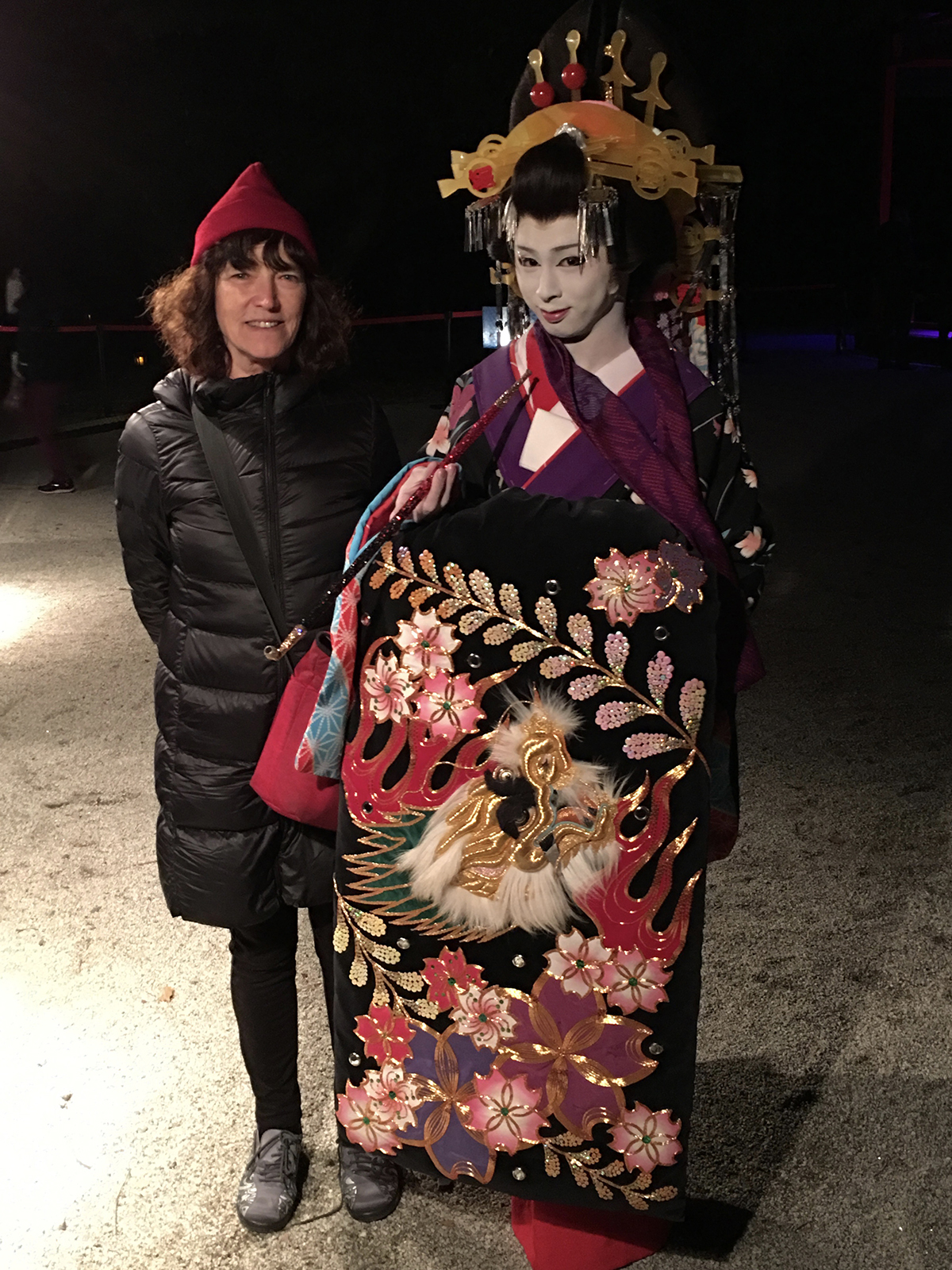
Sandy Edwards and a geisha.
Links…
Museums, temples and shrines
Miho Museum
Open Journal article about the art islands
Benesse Artsite
Isamu Noguchi Museum
Hiroshi Sugimoto artwork Naoshima
Teshima Art Museum
Kiyomizudera Temple
Fushimi Inari Shrine
Philosopher’s Path
Daitokuji Temple
General temples
Teshima Yokoo House
Places to stay
Granvia Hotel
Kyoto Guide
Shizuki Ryokan
Tani House
Shopping, eating and moving about
Giro Giro Hitoshina Restaurant
Teramachi Shopping Streets
Independants Café
Tourist information
Old Kyoto Guidebook
Kyoto Station
Kyoto Tourist Information Centre
Transport from Osaka Kansai Airport to Kyoto
–
Sandy Edwards is a leading Australian photographer, curator and Creative Producer for ArtHere.
Top image credit: Kyoto, photo by Sandy Edwards
Insights from artists working in shattered academic institutions, warnings against group-think, dogma and echo chambers, and thoughts on the paradigm shift in Trump’s USA. The week’s necessary art reads, from the RealTime team, to you.
2017 has brought much discussion of the scarcity of spaces for in-depth art criticism in the Australian media. Sydney museum 4A, a place for contemporary Asian art, has an online publication of unusual breadth for the discussion of art, culture and ideas. This piece by Helen Grace, an artist and academic who works in Hong Kong, draws on an incredible depth of research and personal experience to discuss the ravine of difference between academic cultures in Australia and abroad. Her analysis is particularly relevant for those Australian artists and arts writers who increasingly find themselves squeezed into the structures of neoliberal universities:
“The first of the university restructures I experienced in Australia eliminated support jobs, sweeping through administrative levels, while leaving academic jobs untouched. All this was done in the interests of greater rationalisation and efficiency, leaving highly paid academics to do their own administration — an immediate inefficiency, since it reduced the time academics had to perform the highly specialised jobs they were being paid to do — while the management strata pretended that those administrative tasks were simple, or not even jobs, and acted as if they didn’t exist in any real space and hence required no time.”
Identity politics (IdPol) has become a dominant narrative in contemporary art and public discourse. In a thoughtful and sensitive essay in Right Now, Melbourne writer-editor and former IdPol-adherent Adolfo Aranjuez leads us through the shifts in his thinking over the years, warning against group-think, dogma and echo chambers:
“IdPol is an effective framework for diagnosing what’s wrong with society. The many ills it brings to light — hate-based language, continued colonial violence, inequity based on sociopolitical marker — require redress. But it’s not a viable methodology; it is, like religion, a theoretical system that has, at best, iffy implications when put in practice…by designating a person an irrevocable identity label and making immediate judgments about their political viability, their ethical worth, based on such a taxonomy — as IdPol’s devotees do — IdPol undermines its own core motivation to counteract destructive societal forces.”
Is the art world broken? US critic Jerry Saltz thinks so. His recent essay in New York Magazine reviews a new exhibition addressing Trump’s America, and he wonders whether artists are making work that is relevant to the new social order. If the US art market and the ecology around it is in need of repair, feeling dull and fenced off in comparison to a fracturing political landscape, then what about Australia? Saltz’s article is a call to embrace skepticism and forget defensiveness, to talk frankly about what’s working and what’s not in the art community.
“We’re living through a political paradigm shift, which means that the real world feels excruciatingly alive, with everything at stake and in spin. And yet the more I look for signs of similar vitality in the big-picture art world, where I always look for signs of new life, the more frustrated I’ve become. I think of Marianne Moore’s poem on her beloved subject, ‘Poetry,’ which begins, ‘I, too, dislike it.’ I’ve been thinking this way at least since I visited ‘Wrong Side of History’ last month, an edgy group show addressing Trump’s America, its rising white nationalism, nativism, and Republican cruelty. It’s all politics, but there was enough good art and optical agency in ‘Wrong Side of History’ to recommend the show.”
Much has been made of the suburban setting of Rolf de Heer’s classic arthouse film Bad Boy Bubby. But it wasn’t so much the Adelaide’s spaces but its sounds that interested our writer Annemarie Jonson. A lifetime of imprisonment in his family home means that anti-hero Bubby (Nicholas Hope) isn’t the most verbal character ever. While dialogue is sparse, Rolf de Heer and his nine-person-strong sound team aurally plunge us into the mind of a man who has never heard a violin or a choir or a shitty pub band, “who lives trapped in an underworld crawling with crunchy roaches and humming with fluoro light.” Jonson shows us that this vivid, energised soundscape is key to embedding us deeply in Bubby’s strange, subjective view of his tiny world. In the film’s sideways statement about the claustrophobic nature of the Australian suburbs, its twitching aural landscape completely blows apart the myth of the benevolent, tranquil quarter-acre block. Since Jonson’s article, Adelaide has built on its cinematic reputation as a suburban site for depravity and despair (Snowtown and The Babadook), creepy incest-inflected family drama (Beautiful Kate) and at the less horrific end of the spectrum, late-in-life ennui (A Month of Sundays). Bad Boy Bubby remains the template.
This is the fourth instalment in our series The Deep Archive, which selects highlights from RealTime’s rich, 20-plus-years of publishing. LCH
Sound Boy Bubby
RealTime 3, October-November 1994
Annemarie Jonson listens to Rolf de Heer
Rolf de Heer’s Bad Boy Bubby appeared like some perverse teratology in a cinematic landscape strewn with sequins, high camp reprises of Abba and the ‘irrepressible larrikinism’ that passes for the 90s version of 80s Crocodile Dundeeism. The movie emerged from the chthonic underworld of suburban Adelaide more than a year ago, scoring the Grand Jury Special Prize at the 1993 Venice Film Festival before being picked up by Roadshow for local distribution — hence the bizarre juxtaposition at mainscreen cinemas of Bubby’s coming out, Priscilla’s odyssey and Muriel’s wedding.
Bubby is a feral Kaspar Hauser, teleported into the fin de siècle antipodes. He lives, or rather subsists like a virus dependent on his psychotic mother in a putrid, windowless cesspit set in an apocalyptic industrial wasteland. Bubby passes the time by committing unspeakable acts on the family pet and resident vermin. (Has the RSPCA seen this film?) He fears God and mother in equal amounts and regularly ‘services’ the latter. Bubby has never seen the world nor another human being in his 35 years; since mother dons a gas mask each time she leaves, he’s convinced he’d asphyxiate in the noxious outdoors. Like an ancient married couple in a hermetically sealed universe, the two are set in their quaint little quotidian rituals: she washes him, feeds him sugared bread and milk, and thrashes him; he fucks her, fondles her pendulous breasts and applies her lipstick — Princess Pink. (This movie, incidentally, is a psychoanalytic minefield. It scores an A+ for misogyny and rampant breast fetish. Dr Freud, the chaise longue for Mr de Heer please!)
The deeply pathetic ‘comfort’ of Bubby’s subsistence is shattered when his ‘Pop,’ a drunken low-life with a sideline as a cleric who ‘stepped out’ 35 years ago, returns to compete for mother’s affections. This cataclysmic event completes the Oedipal interdiction. Bubby is catapulted into the social order, but not before he improvises a Gladwrap Christo to sever family ties.
Bubby’s pilgrimage through contemporary Australian suburbia is a mix of violent abuse, the kindness of strangers and humanistic empathy. It takes in environmental degradation, disability, institutionalisation, religious fanaticism, pub rock and quantum physics. Norman Kaye appears in bizarre cameo as an atheistic, church-organ playing physicist who initiates Bubby into the chaotic mysteries of existence: “All we are are random arrangements of atoms. We don’t live, but our atoms move about in such a way as to give us identity and consciousness.” But one of the most interesting things in this quite remarkable film is the central role of sound. Bubby is an acoustic tabula rasa: he reflects like an aural mirror all that he hears, memorising and mimicking voices and sounds in a kind of innocent echolalia.
Bubby’s aural disposition is reflected in the film’s sound design by James Currie. The sound was recorded primarily via binaural radio mics attached to Bubby’s wig (a system devised by Fred and Margaret Stahl) through which we get to earwitness Bubby’s life. In the first part of the film the claustrophobia of Bubby’s dungeon is heightened by the incessant hum of the fluorescent lights, whining like the nervous system in an anechoic chamber. Currie ‘magnifies’ the small, inconsequential, normally unheard sounds of the everyday in Bubby’s underworld: the scraping of the shaver on his cheeks, the dripping of the tap as he waits motionless for his mother’s return, mixed into the sound of Bubby’s piss dripping through his chair, the rubbing and swishing of the flannel as mother washes Bubby down. And Bubby’s voice, close mic-ed against the spare, aural backdrop cuts through like a knife as he hisses at the cat, crunches cockroaches and punctuates the near silence with occasional bursts of monosyllabic babytalk.
When Bubby finally sets himself free the aural epiphanies begin in earnest. One of his first encounters is with a celestial Salvo choir mysteriously plonked in the Adelaide docks and reverb-ed to the heavens. Walking past a warehouse after robbing a service station, Bubby is mesmerised by the sound of a violin. When Bubby is thrown in jail, a phalanx of kilted bagpipe players appear out of nowhere and Bubby goes ballistic trying to locate the source of the sound. Once released Bubby is drawn into a cathedral by a brilliant Messiaen-like organ improvisation by Kaye. A member of the band which Bubby joins — yes, he stumbles into a vocation as a spoken word performance artist — performs an Islamic chant as he relates to Bubby a potted history of religious jihads through the millennia.
The aural preoccupation of the film reminds us of the epigraph to Hauser: “Do you not hear the pitiful screams all around us, which are commonly called silence?” But this is a little tragic and portentous for de Heer’s often very funny film. As it happens, Bubby ends up in a perverse kind of marital bliss, gamboling with his progeny in a semi-suburban quarter acre — adumbrated by an industrial plant spewing carcinogens over the pansies.
–
Annemarie Jonson wrote for RealTime and worked on its editorial committee in the 1990s. With Alessio Cavallaro, she co-edited its OnScreen supplement. She has a PhD in art theory from the University of Sydney and is CEO of the Sherman Centre for Culture & Ideas, launching 2018.








































